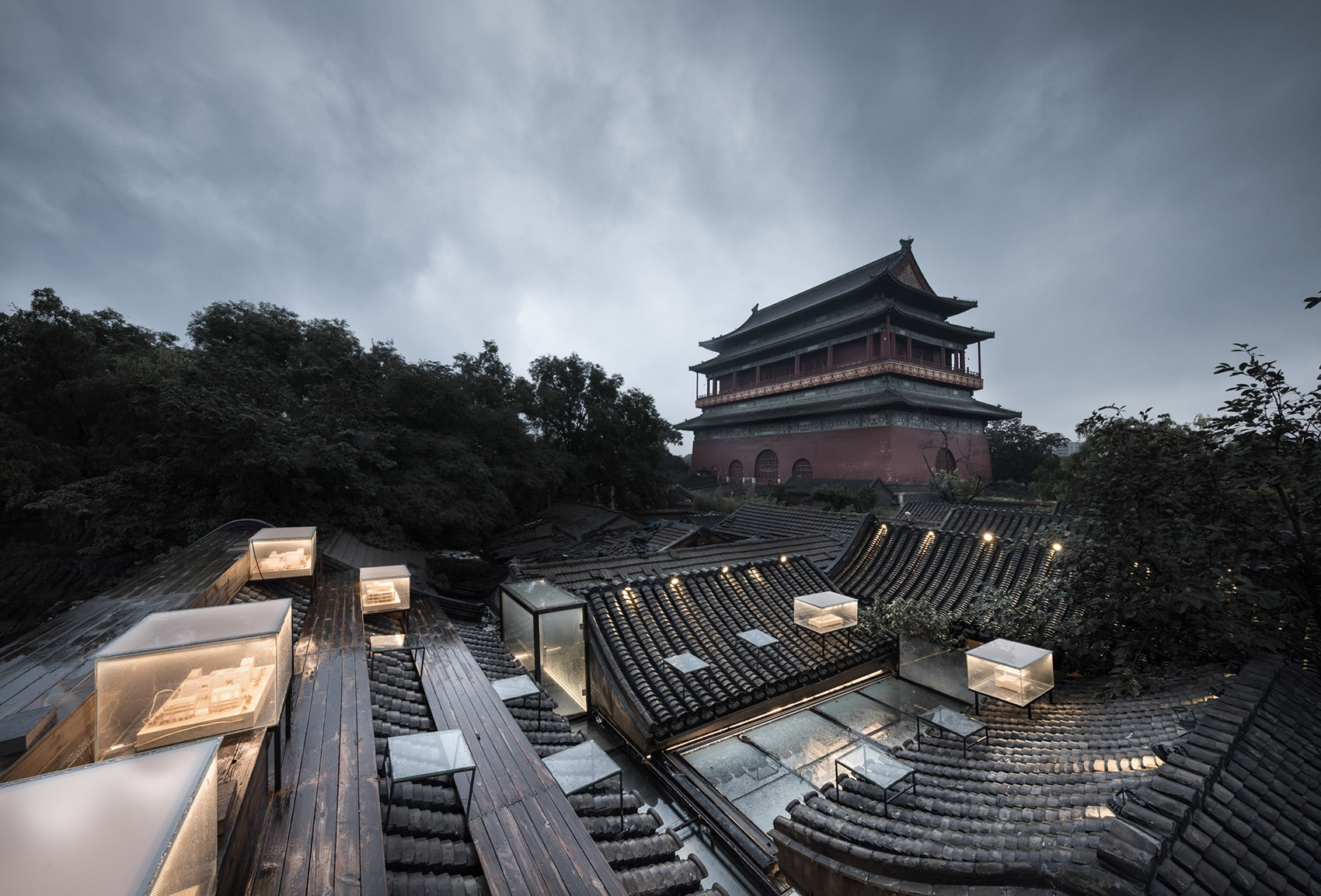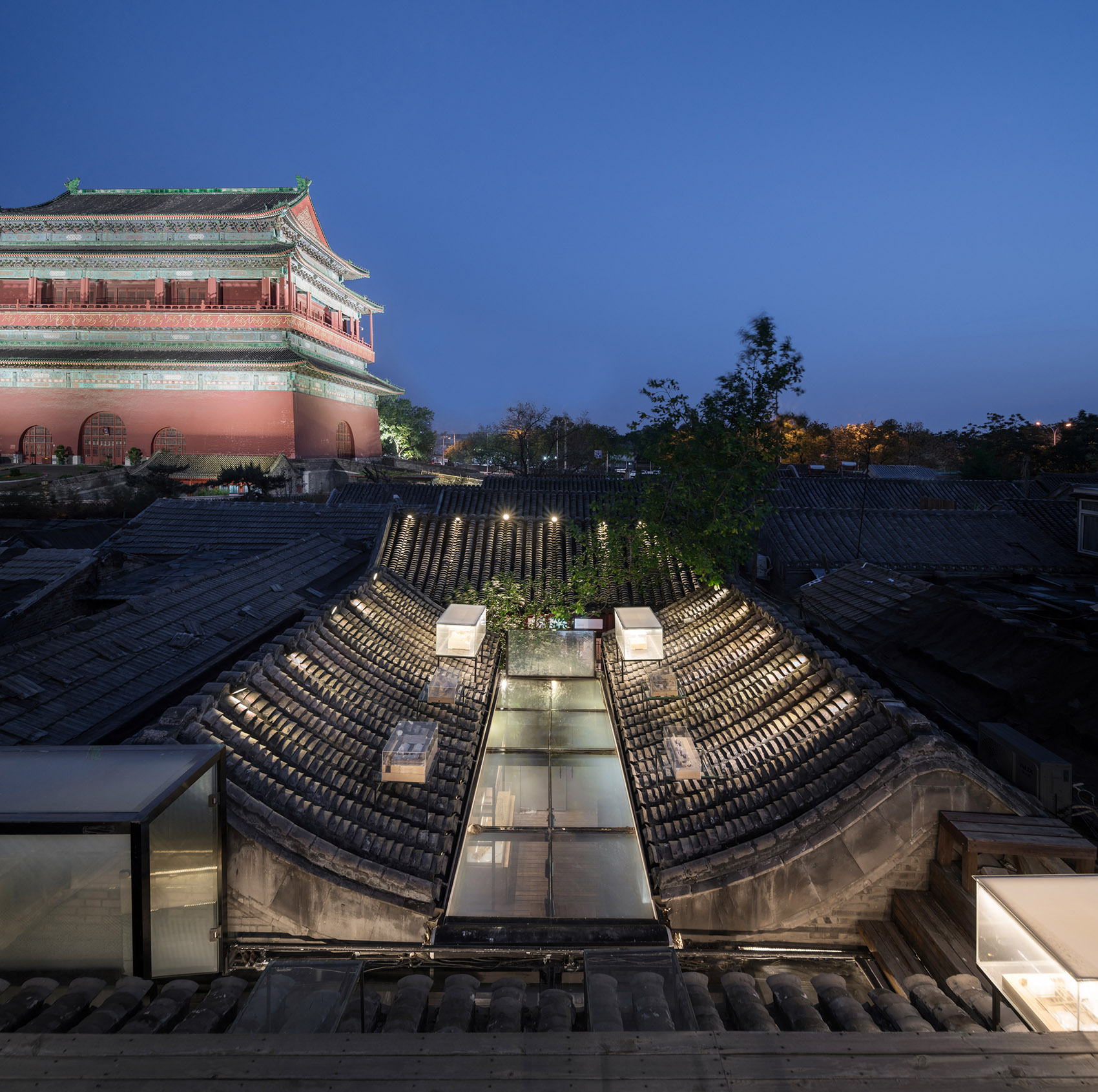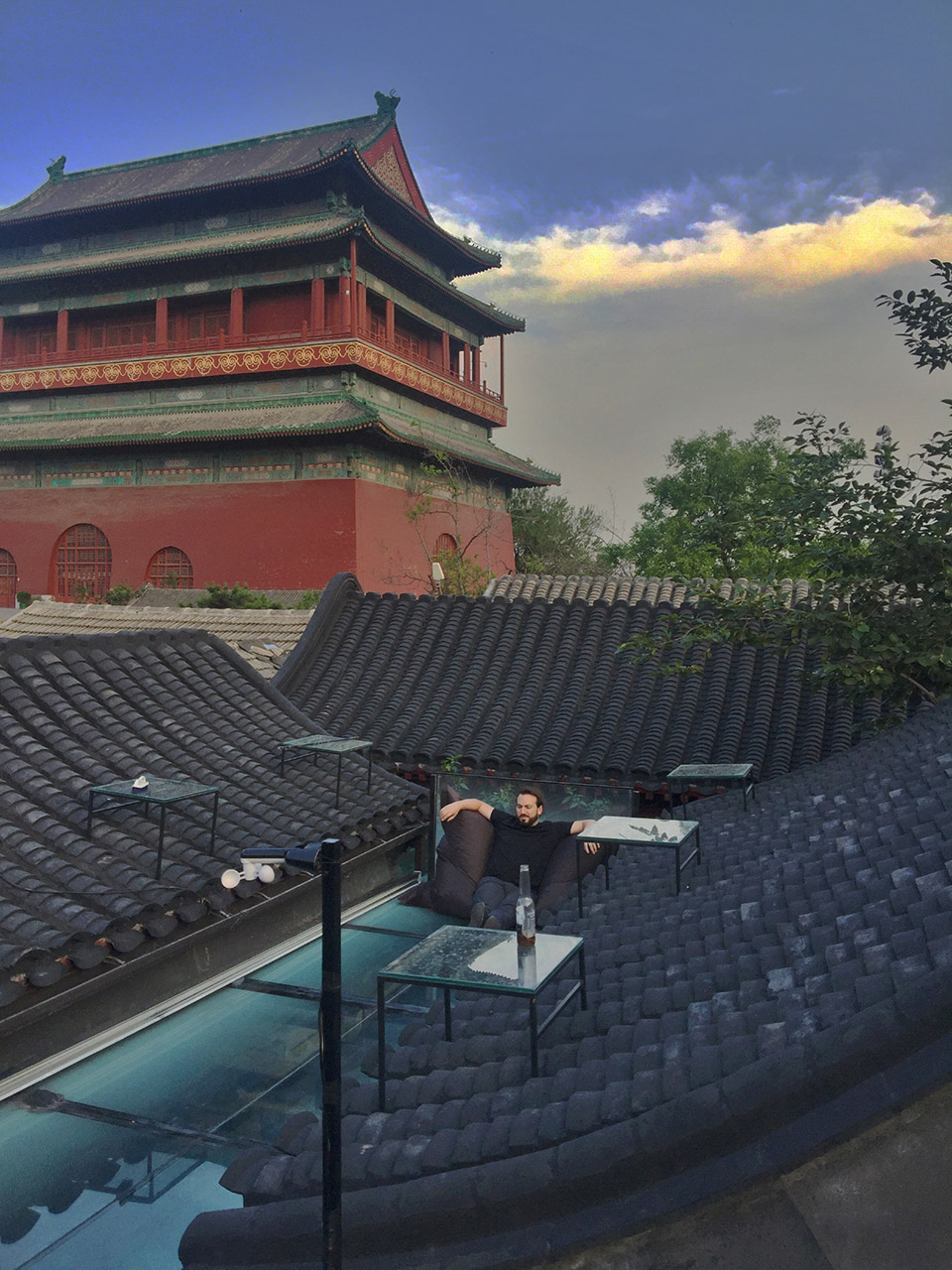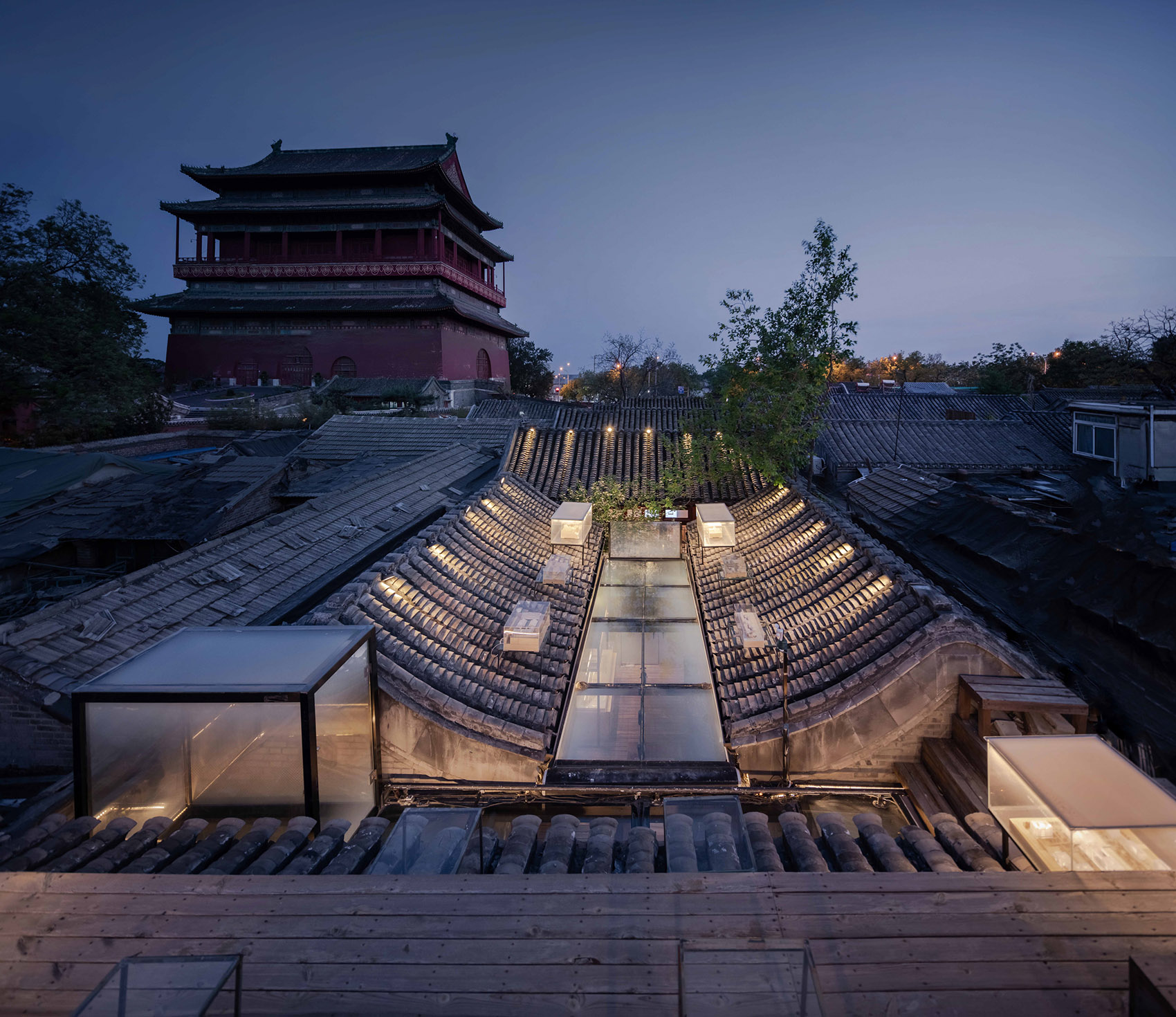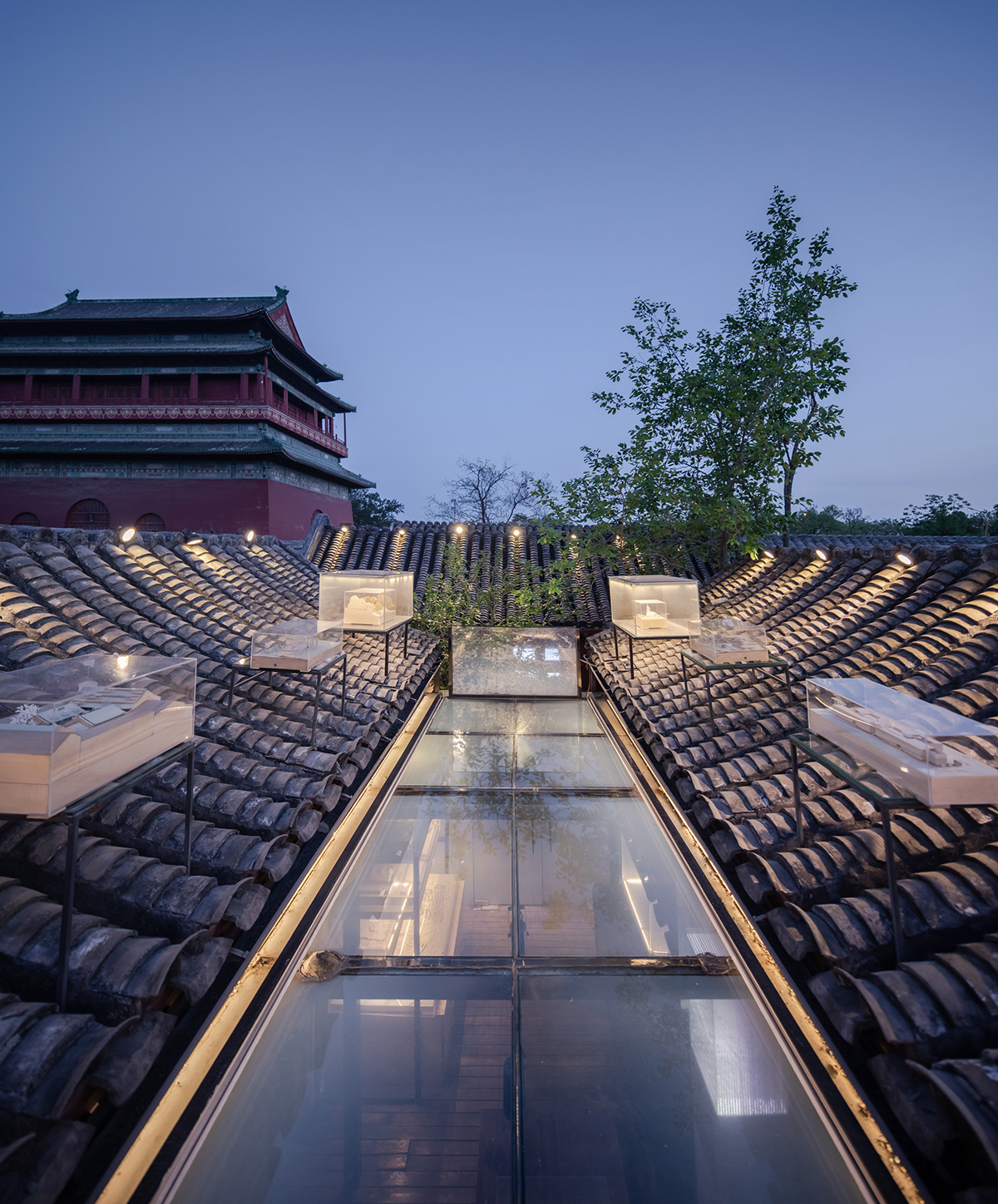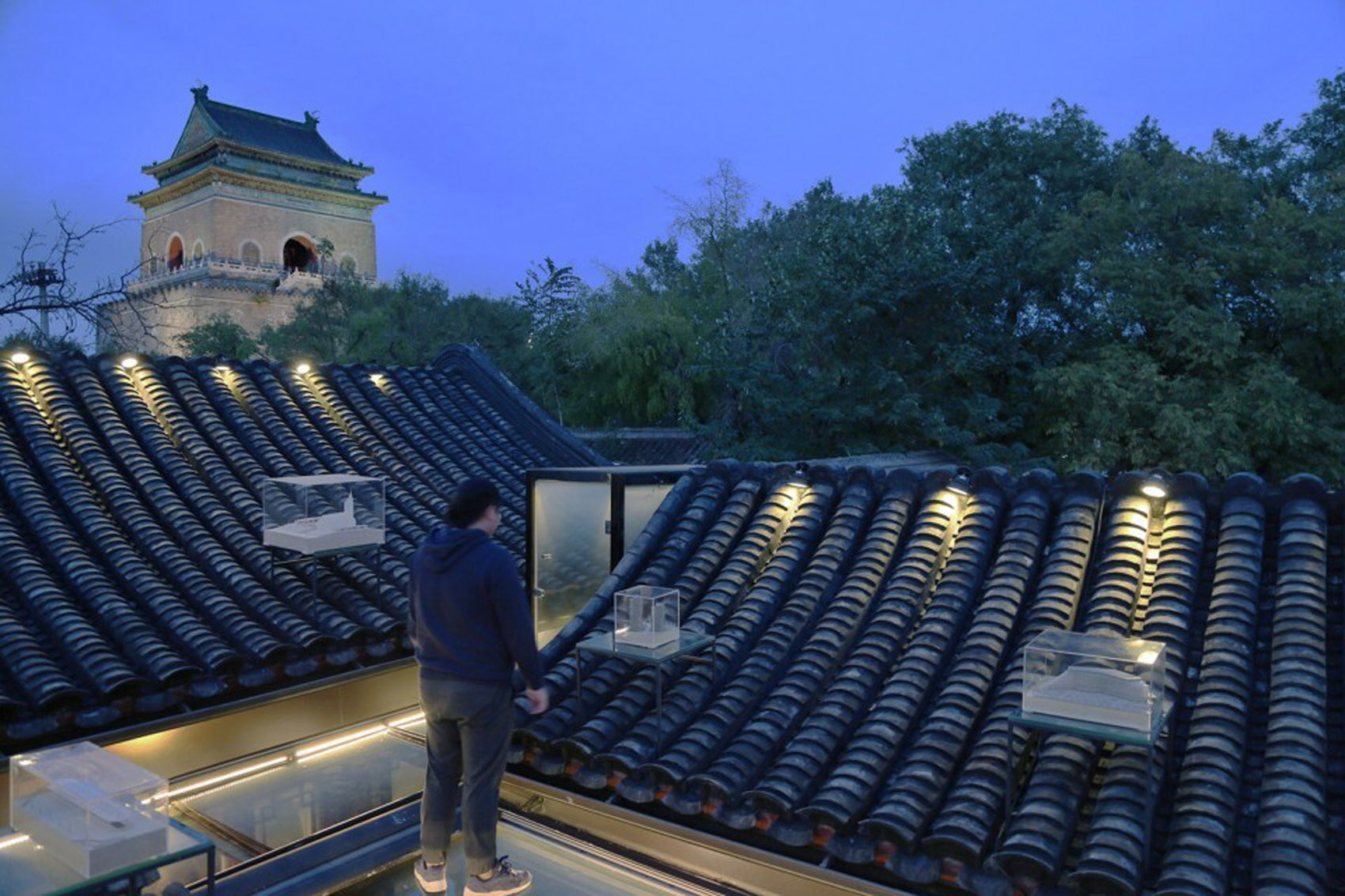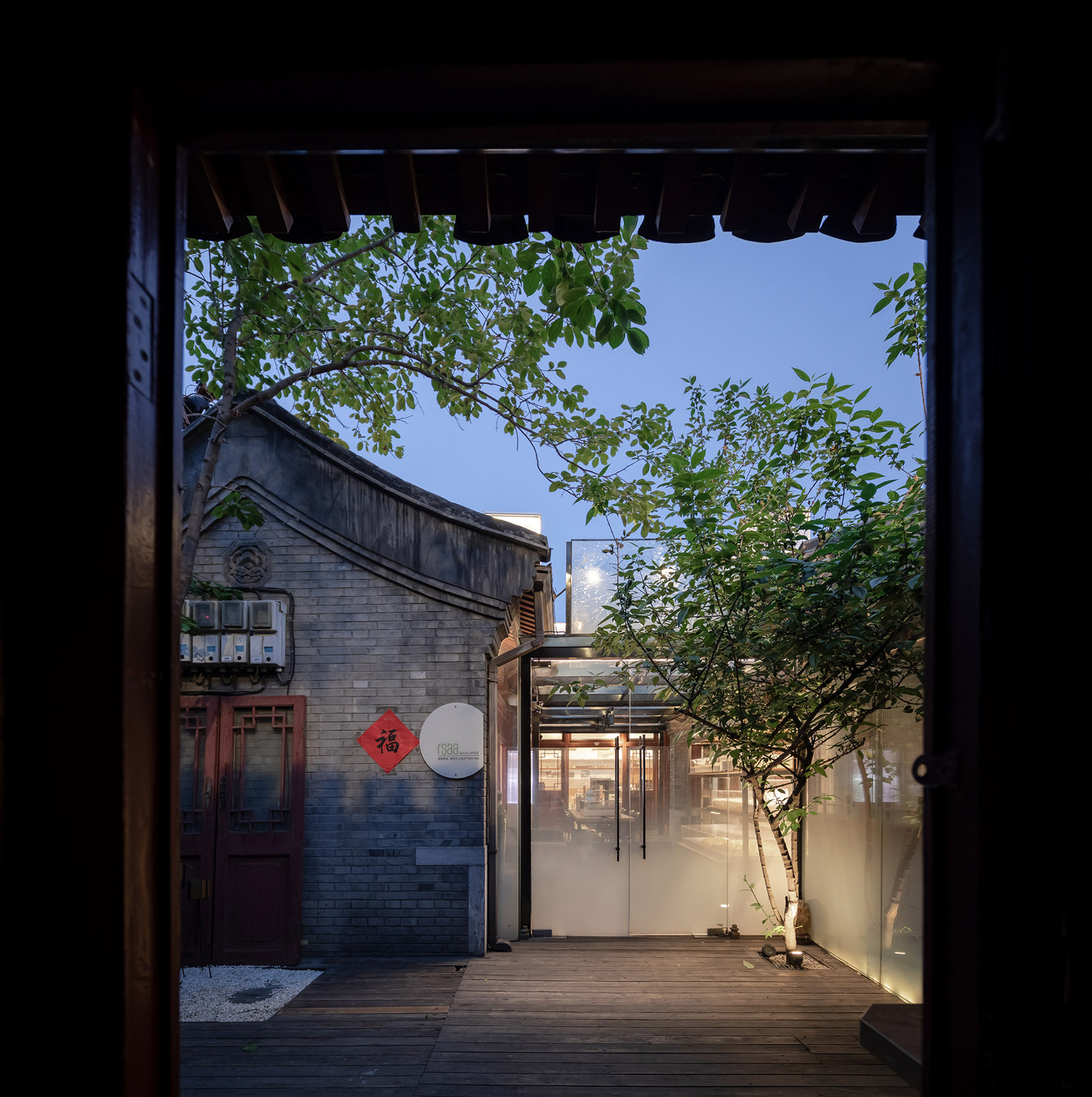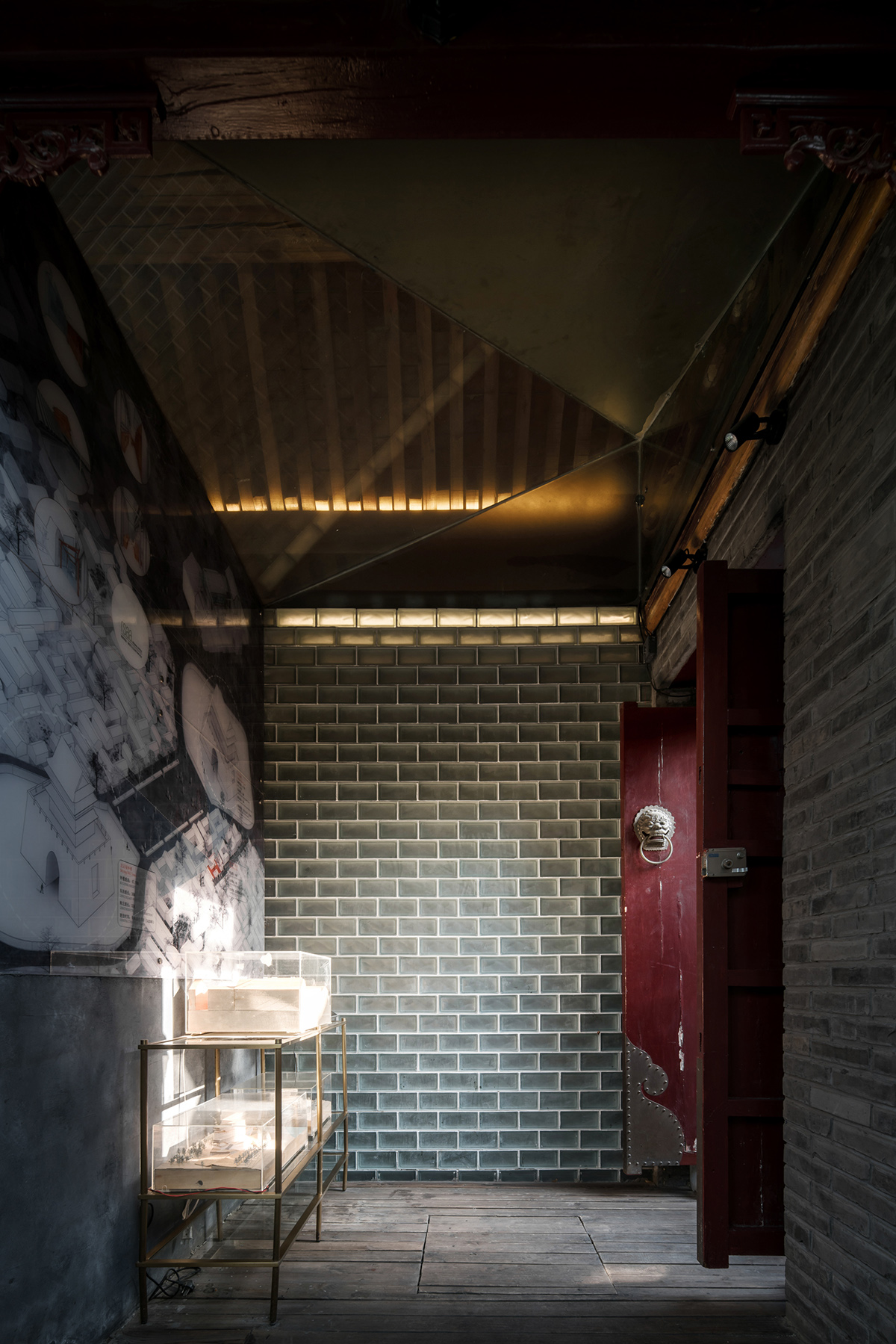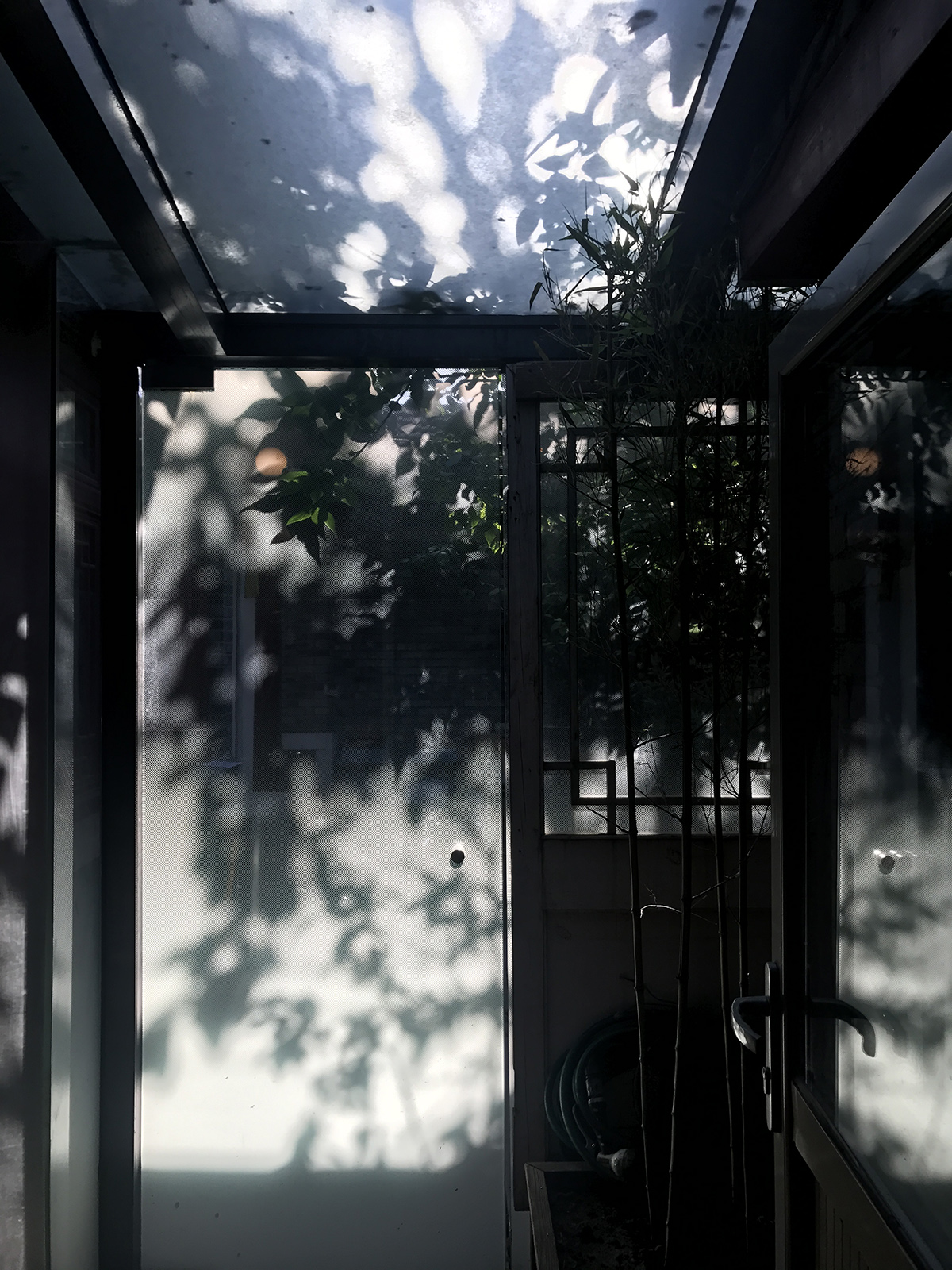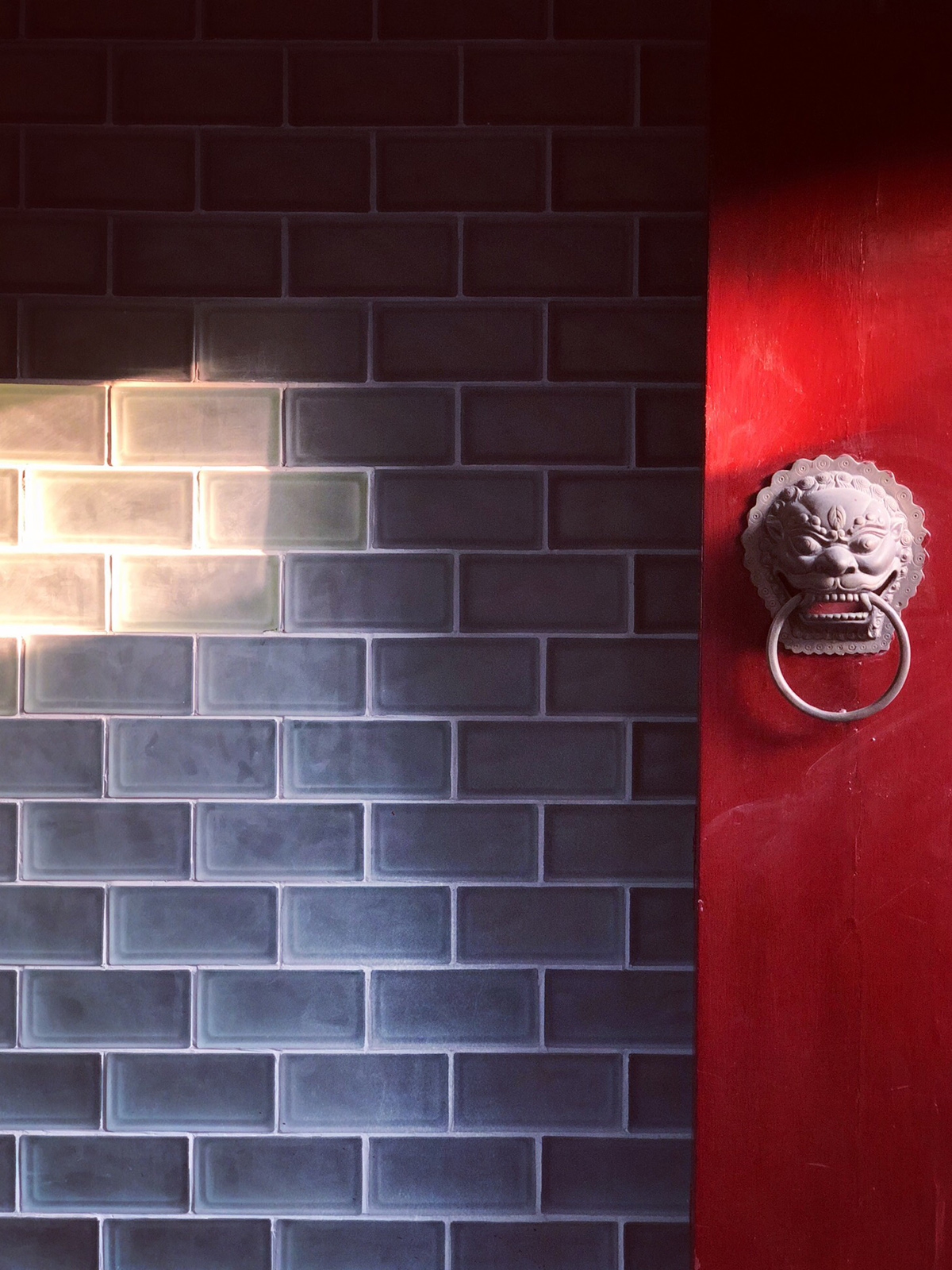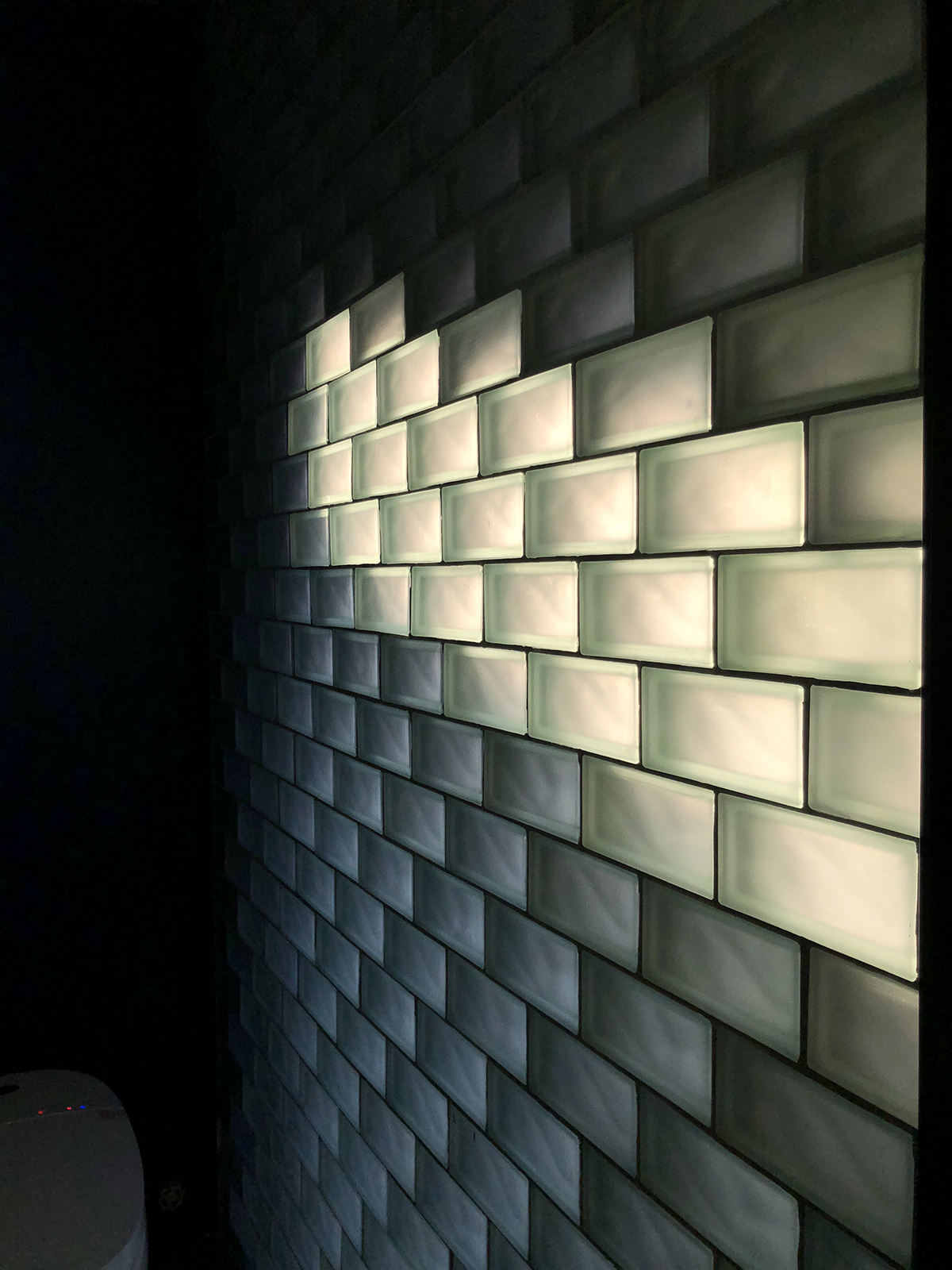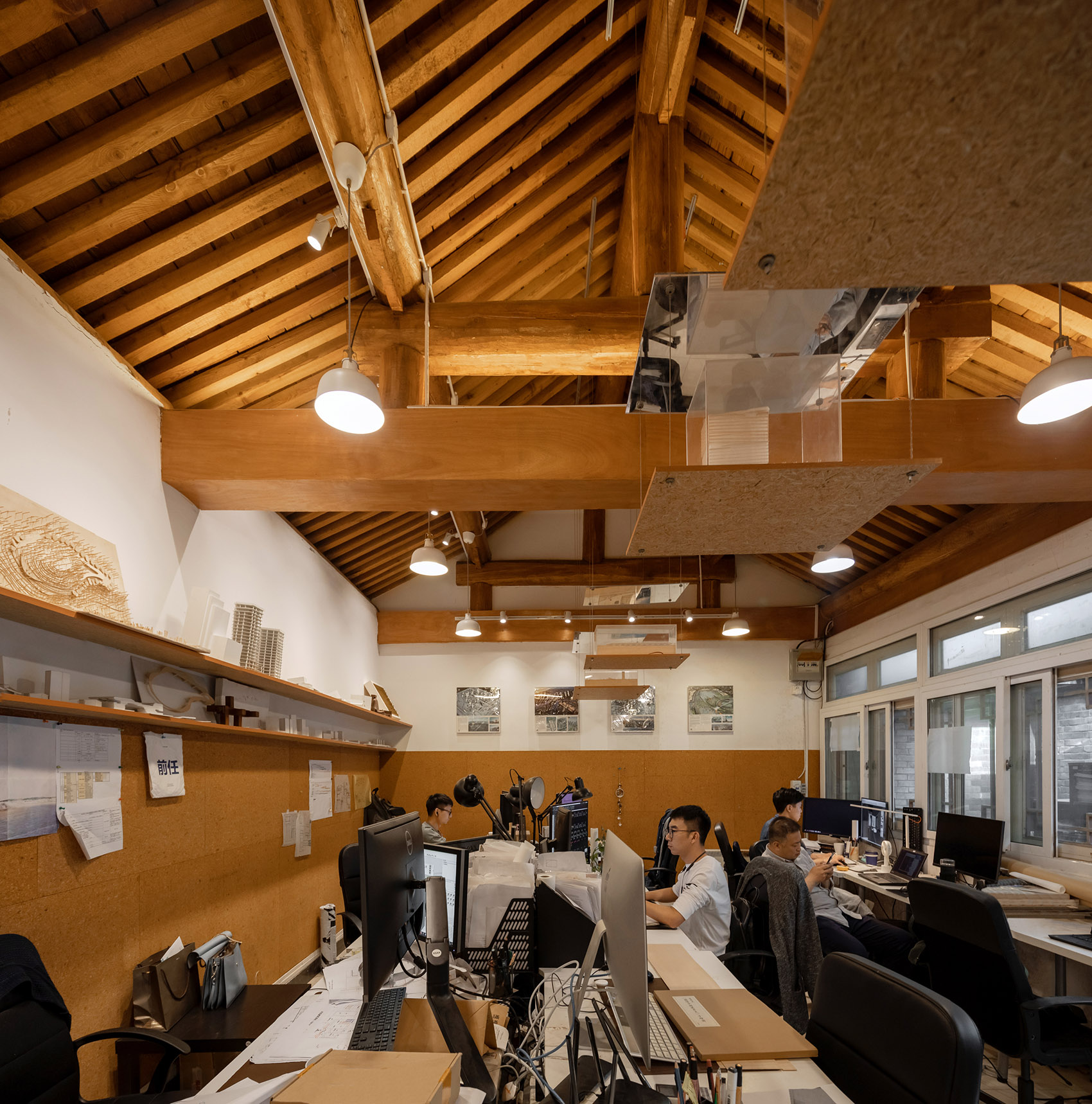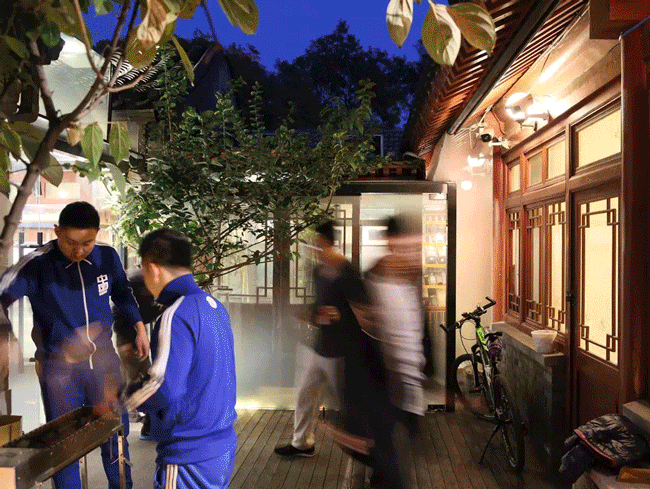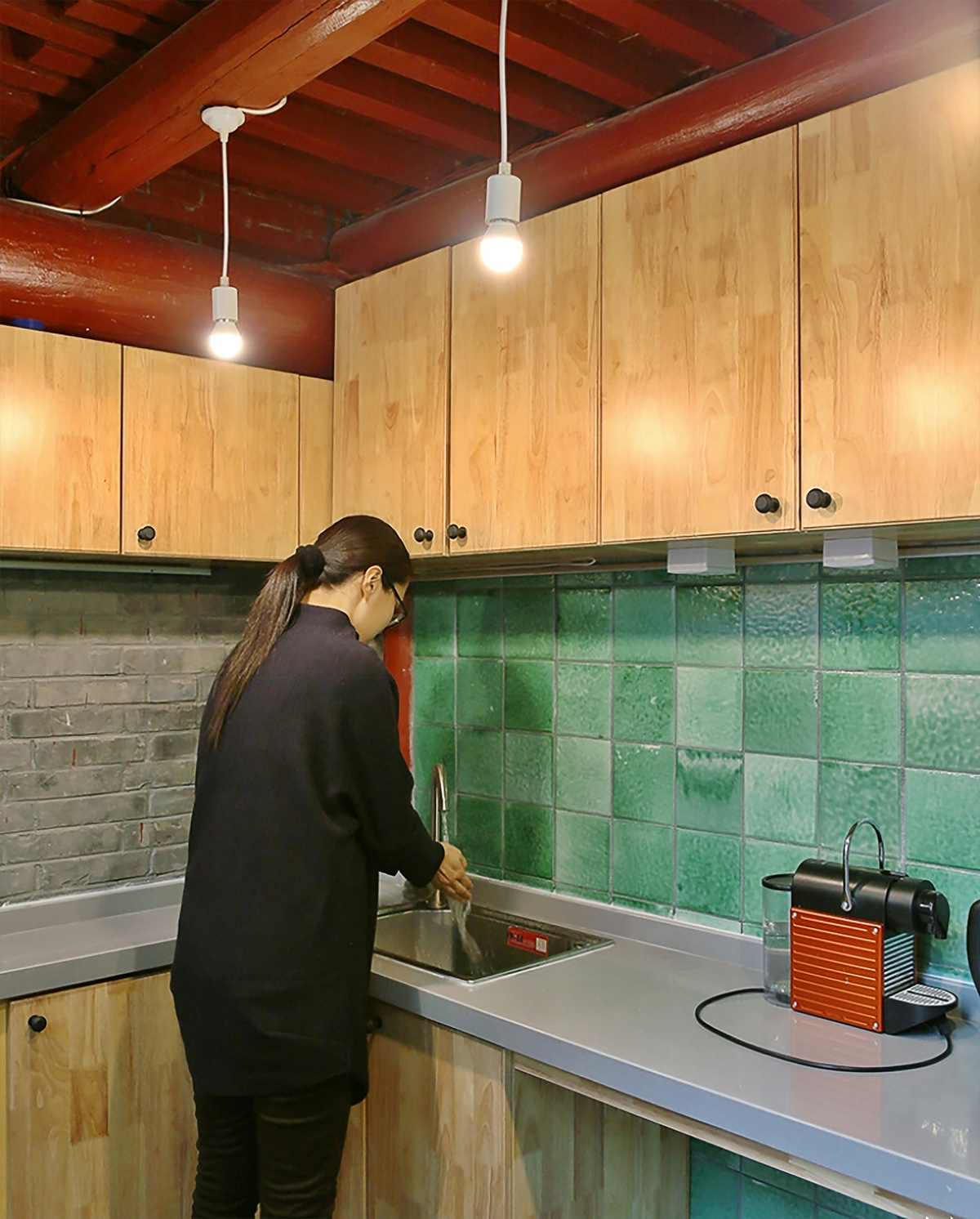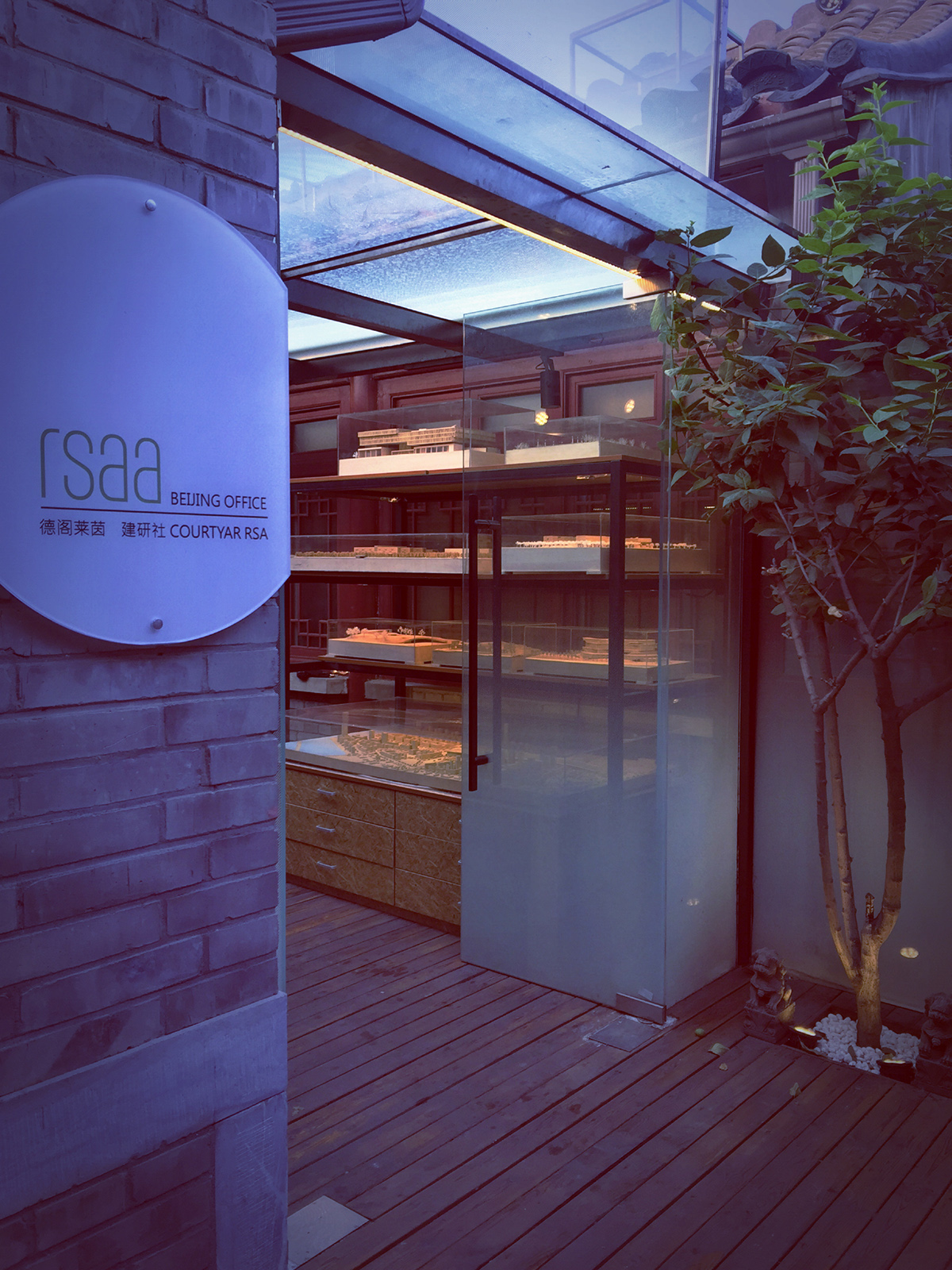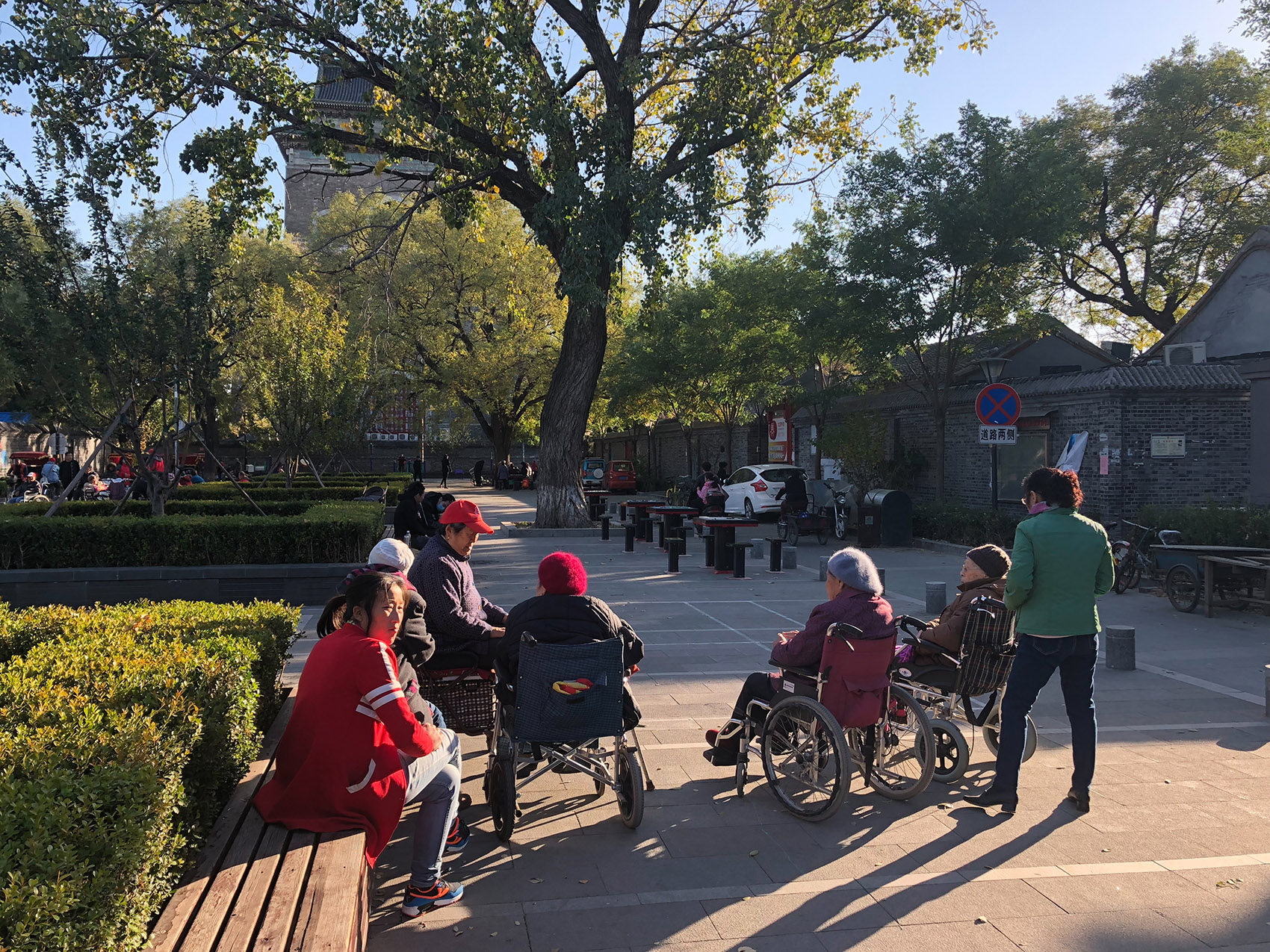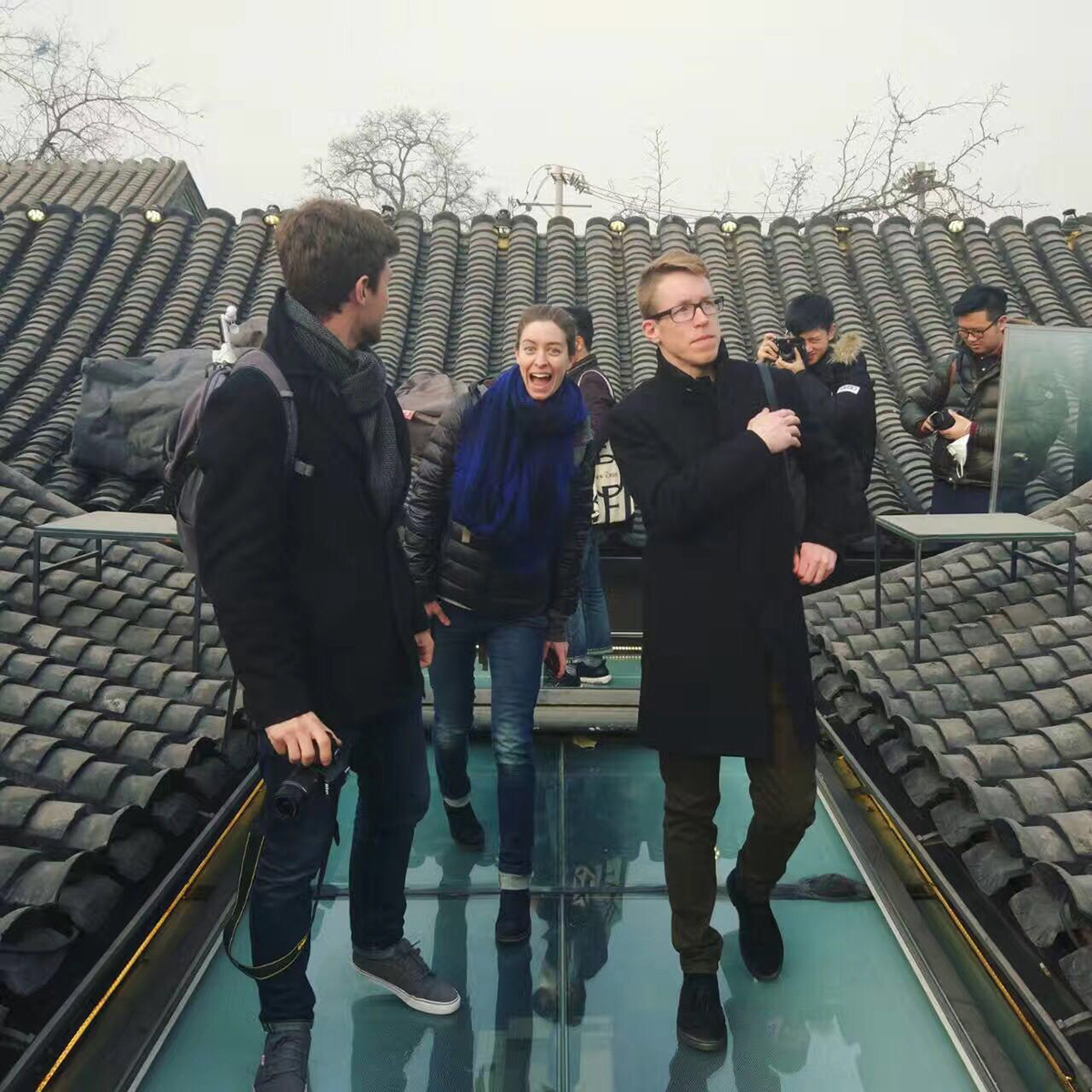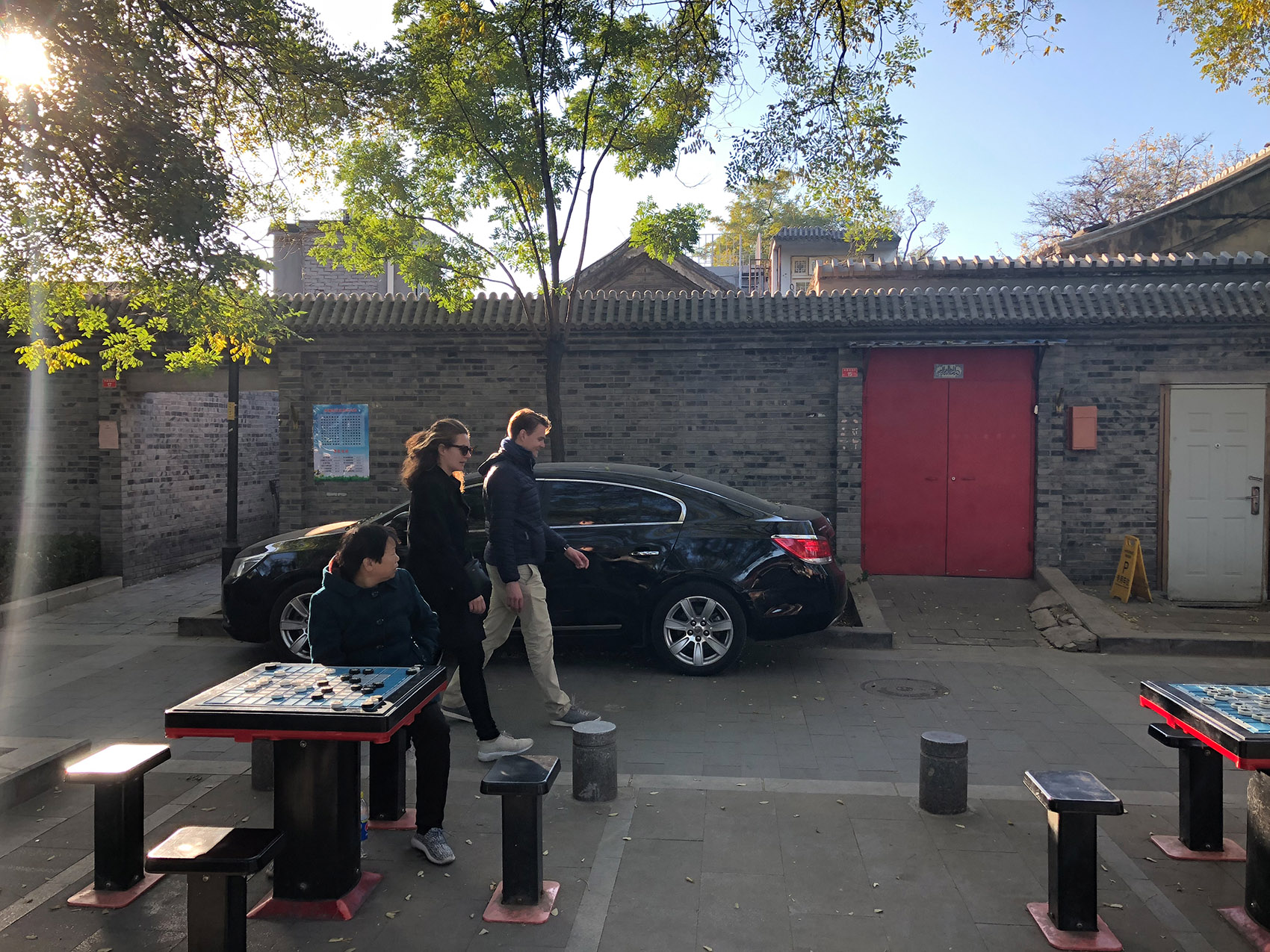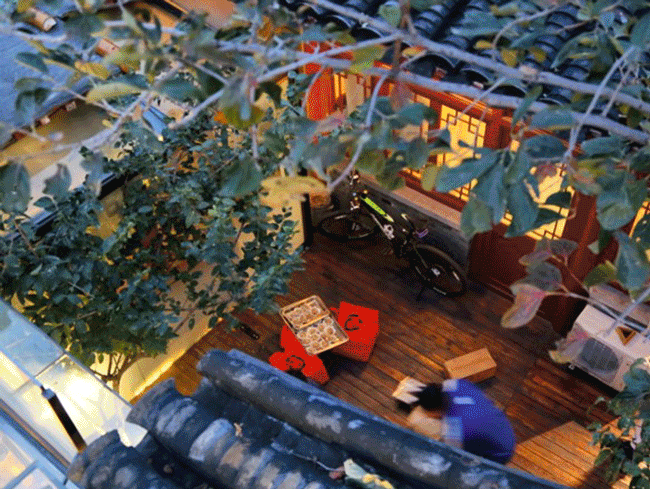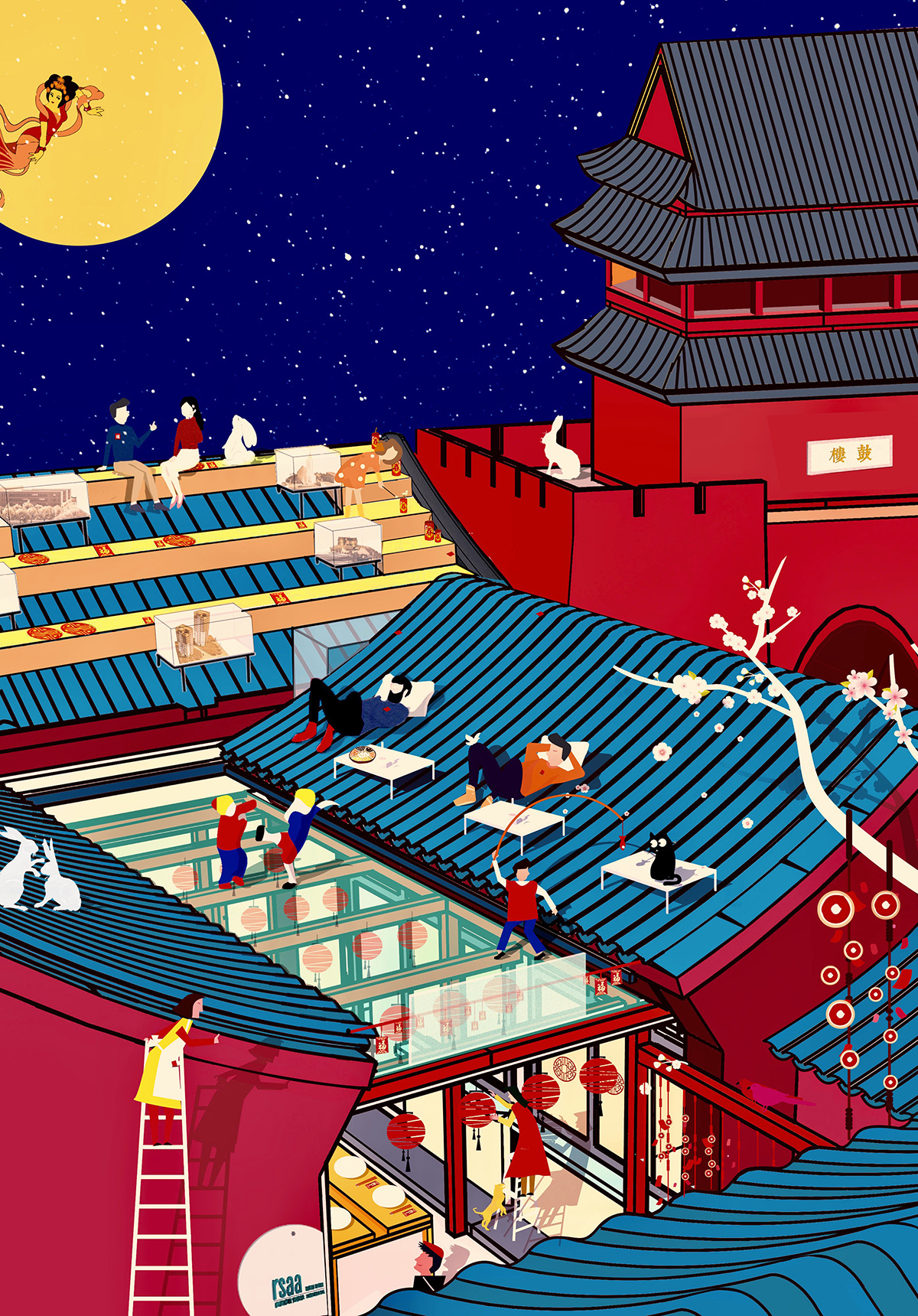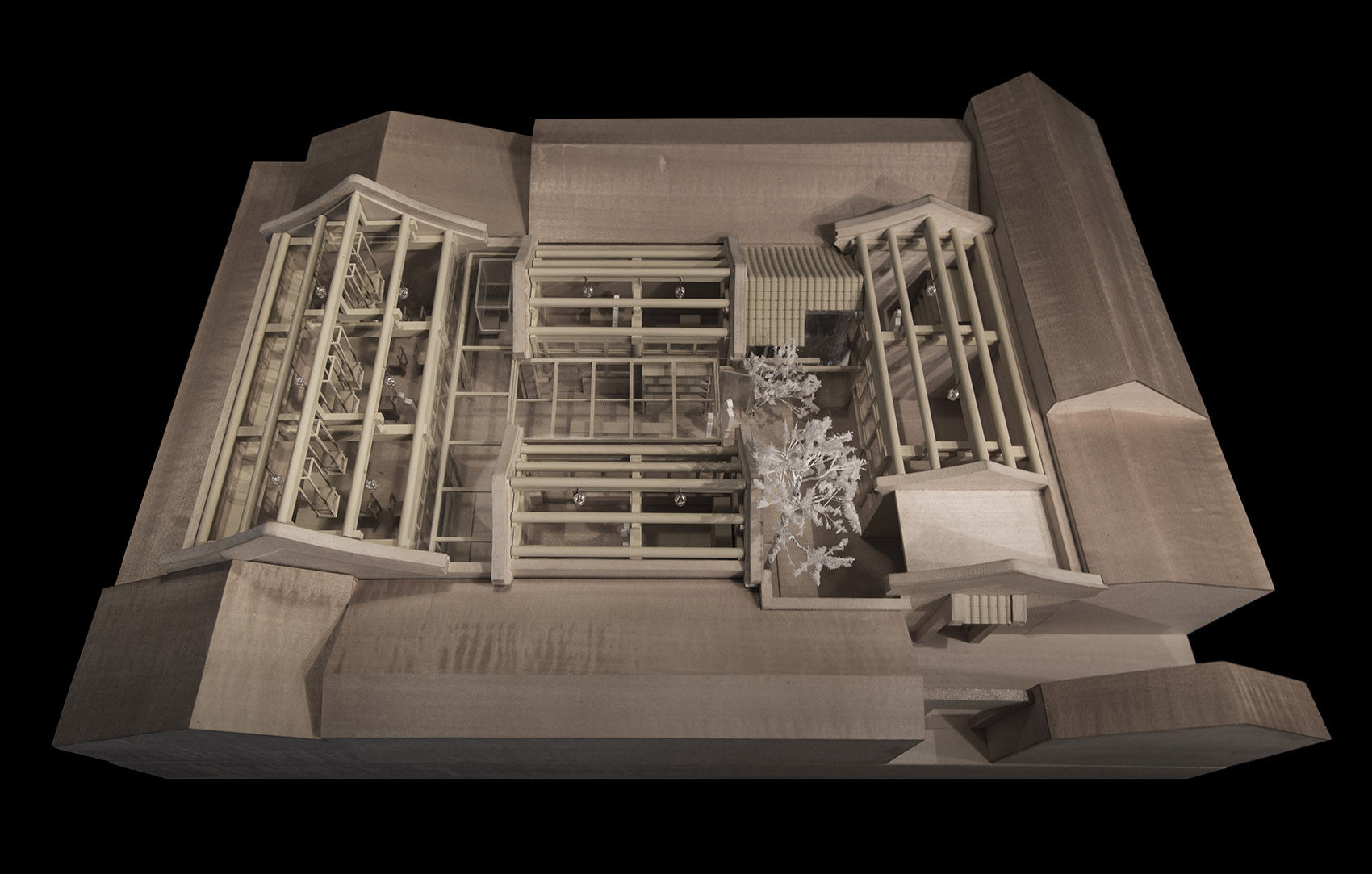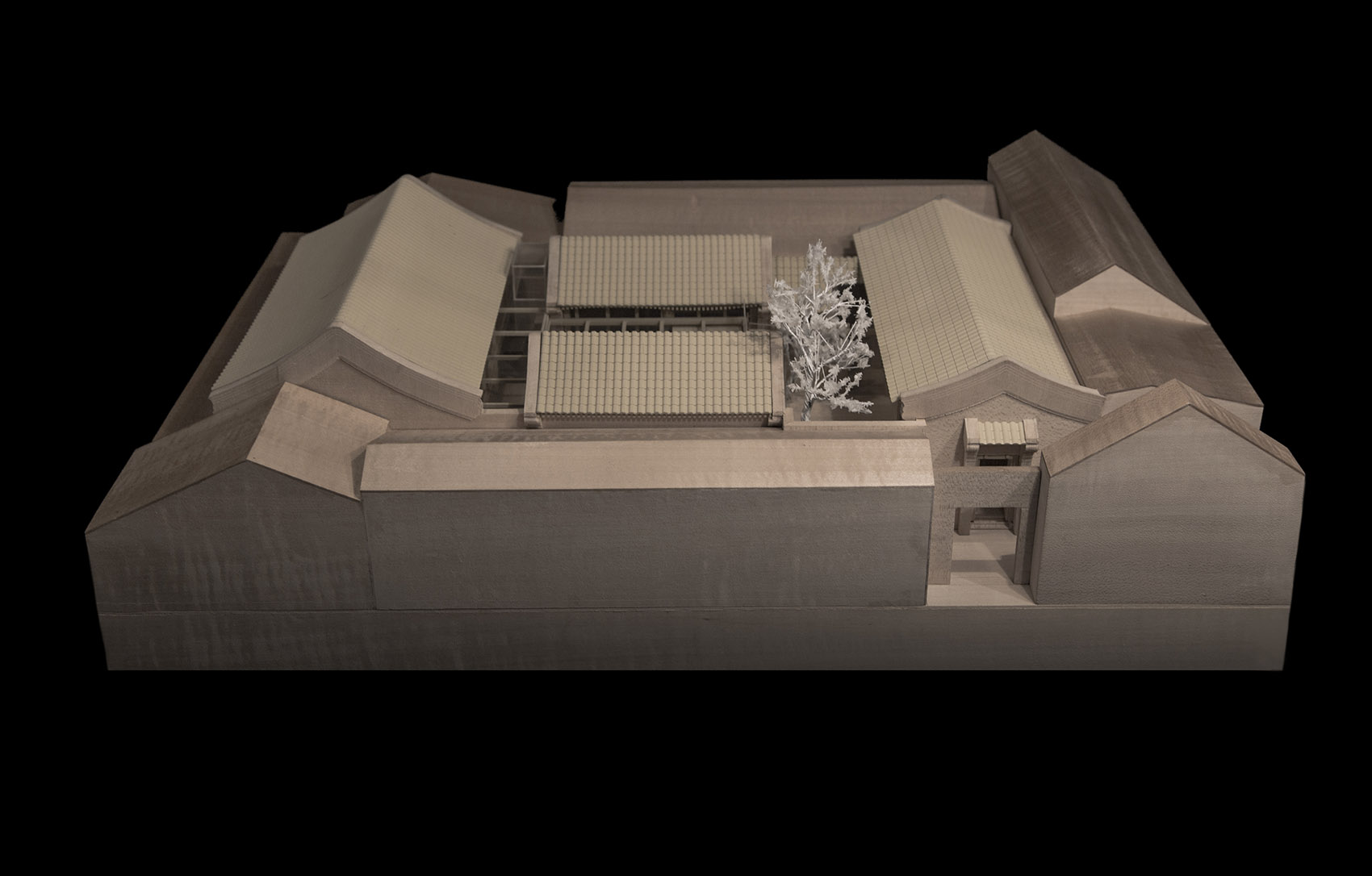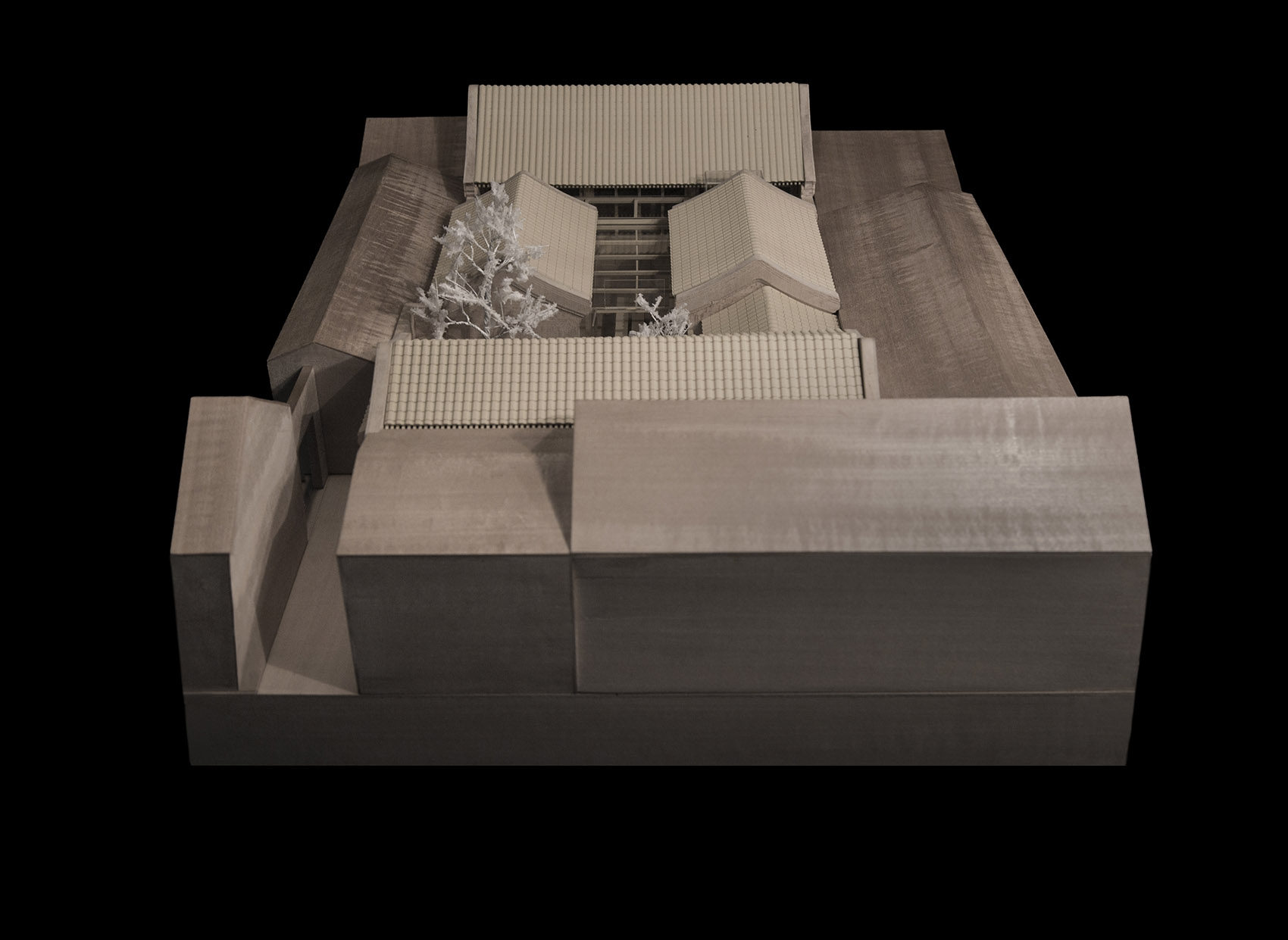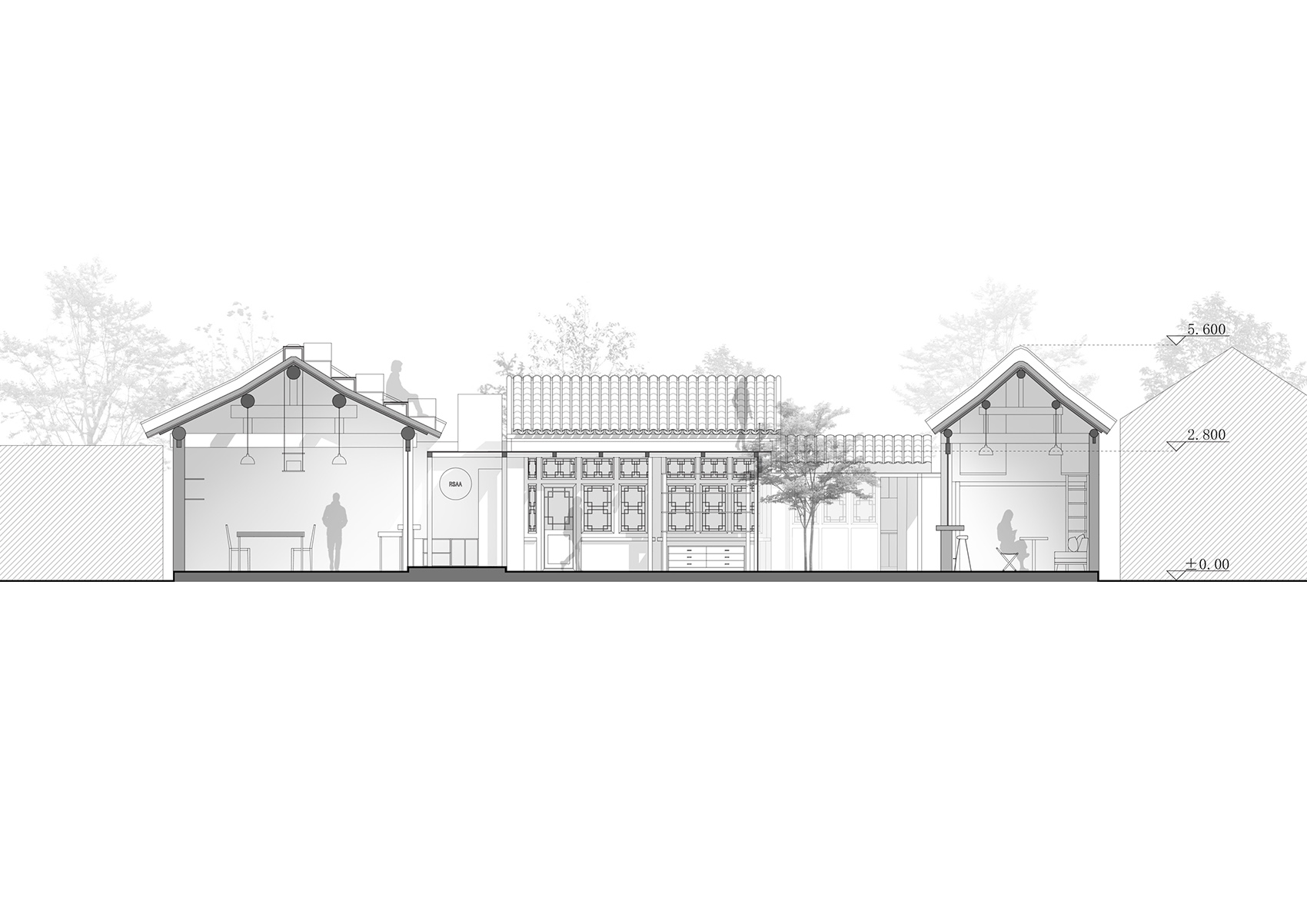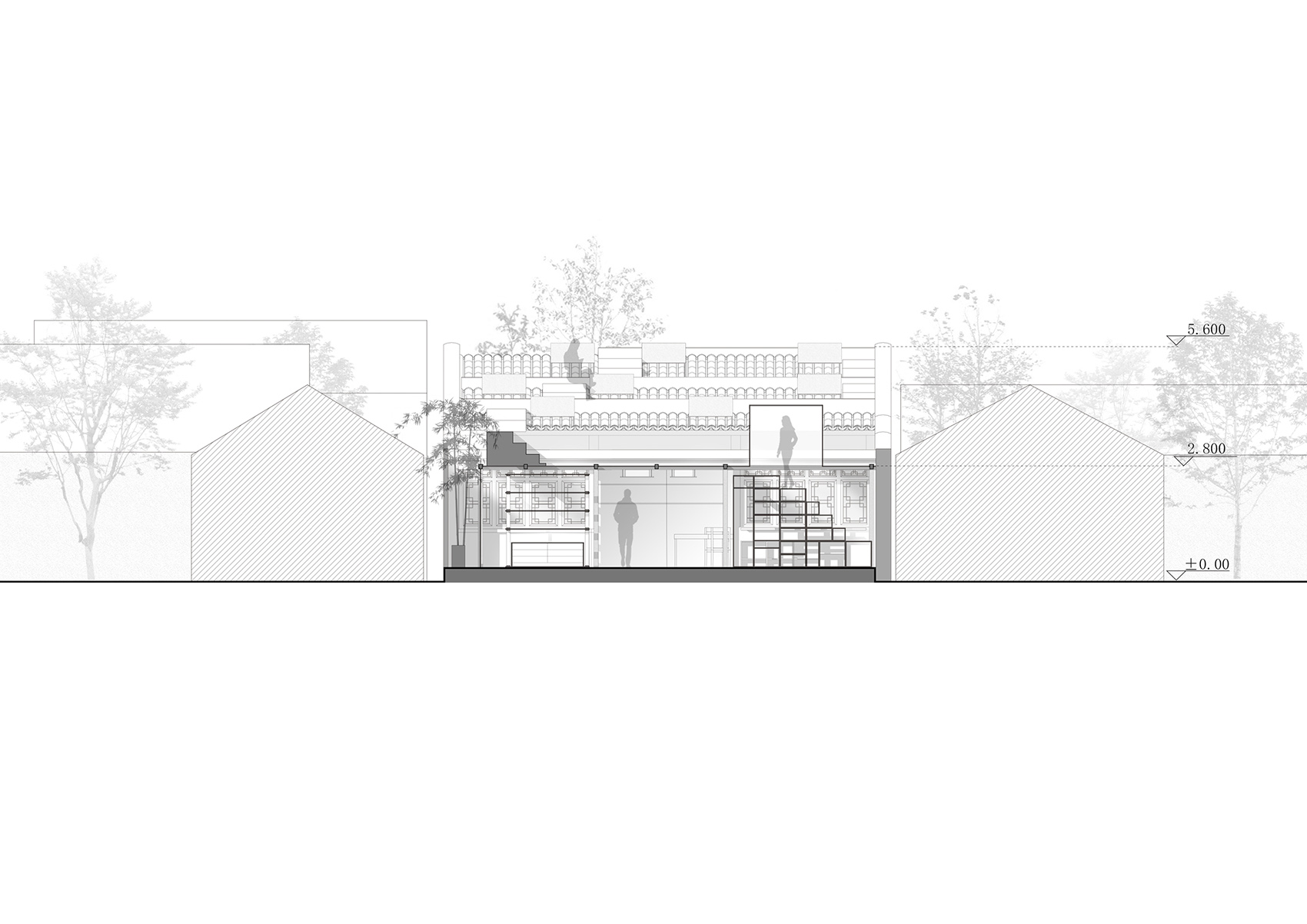“我们不认为我们应该造一个你以前生活过的老院子让你全然的重温过去;我们只是创造一个窗口,从这里窥视你依然能找到儿时上房揭瓦的兴奋,打柿子的愉悦,看鸽子时的畅快,但同时真正激动人心的,是这些传统的片段却组成了一个属于未来你不曾体验过的空间。”
“We don’t think we should make an old courtyard so you can relive the past of growing up; we just create a window from which you can still find the excitement of going up to the house, the pleasure of hitting persimmons, the pleasure of watching pigeons, but at the same time, what is really exciting is that these traditional fragments form a space that belongs to a future you have never experienced before…”
▼庄子玉工作室鼓楼7号院,Buro Ziyu Zhuang’s Gulou No. 7 Courtyard © BUZZ庄子玉工作室
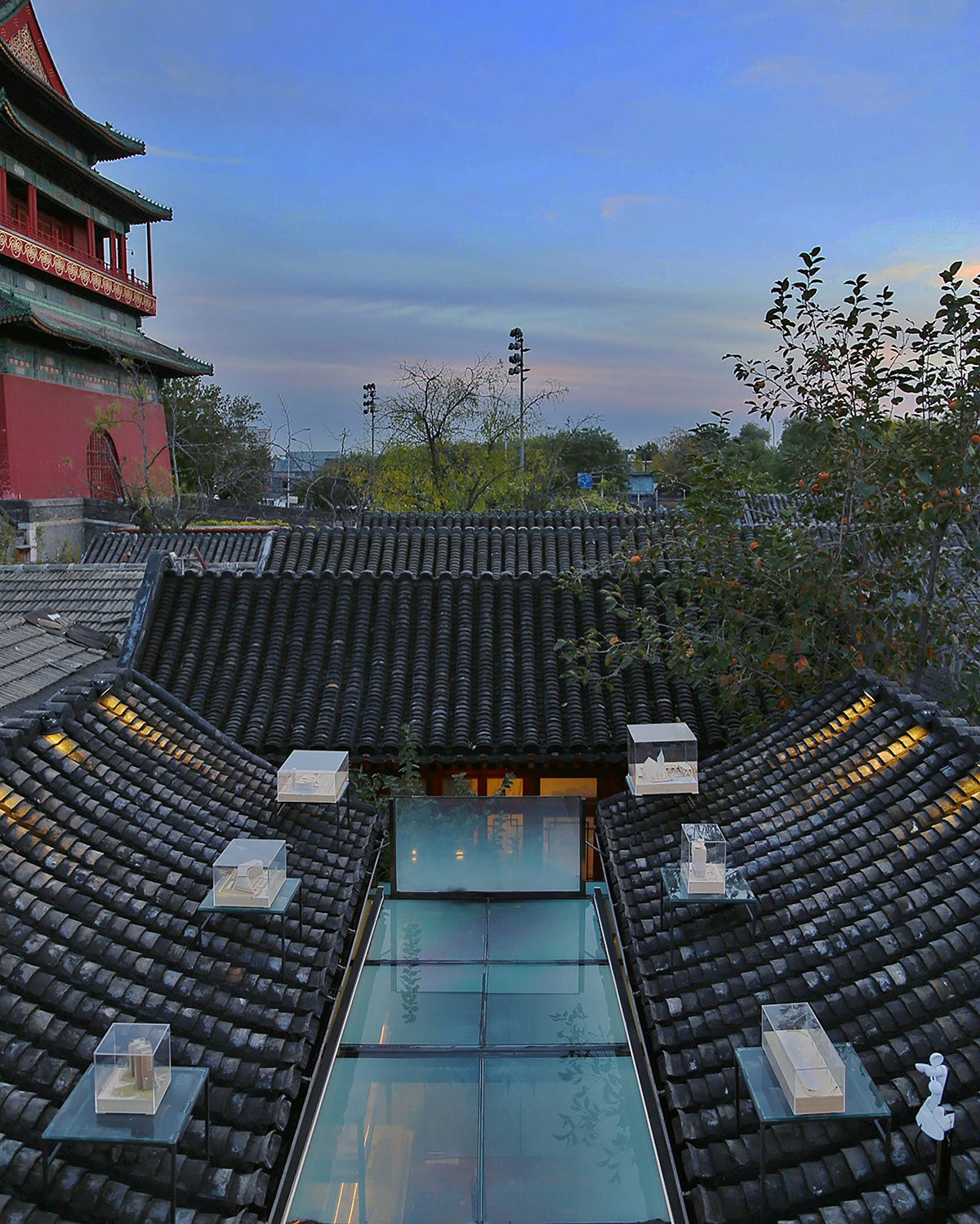
2015年,BUZZ庄子玉工作室,从国贸标准化的办公楼搬到了钟鼓楼旁的一座老四合院,走出了纯粹的办公场景,融入了北京的日常生活。
In 2015, BUZZ Buro Ziyu Zhuang moved from a regular office building in China World Trade Center to an old courtyard next to Drum and Bell Tower, moving out of the corporate office scene and into the daily life of Beijing.
▼入口露天庭院,Outdoor entry yard © BUZZ庄子玉工作室
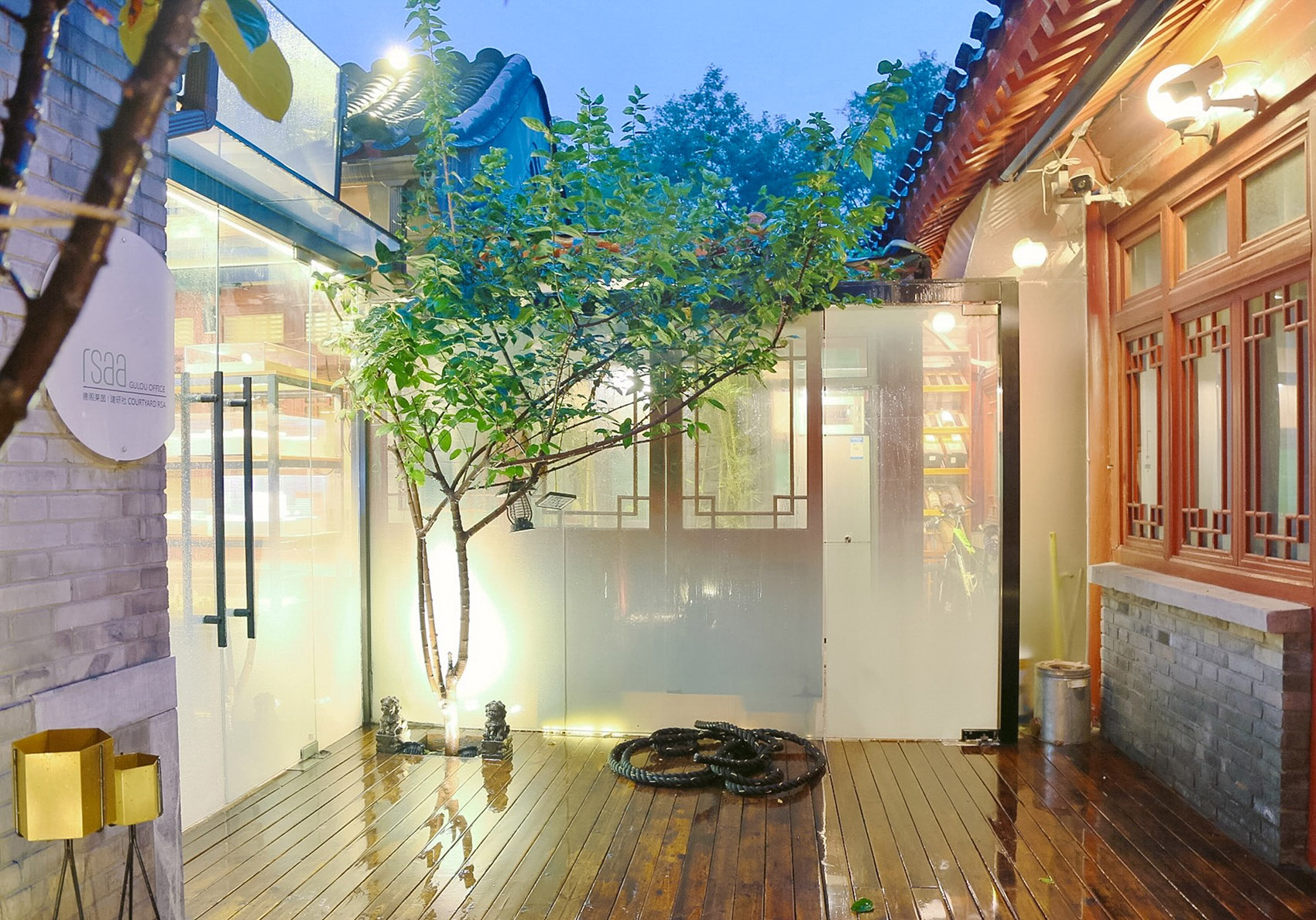
6年间,这里完成了许多令人印象深刻的设计,亦有大量灵感和原型的源起这个院子。鼓楼7号院,也成为了团队探索建筑空间关系和当代中国人生活方式的原型伊始。
6 years later, many impressive designs have been conceived here, and a large number of inspirations and prototypes originated from this patio. No. 7 Gulou Courtyard also became the model for the team to explore the relationship between architectural space and contemporary Chinese lifestyles.
▼鼓楼7号院屋顶,Rooftop view © 张辉
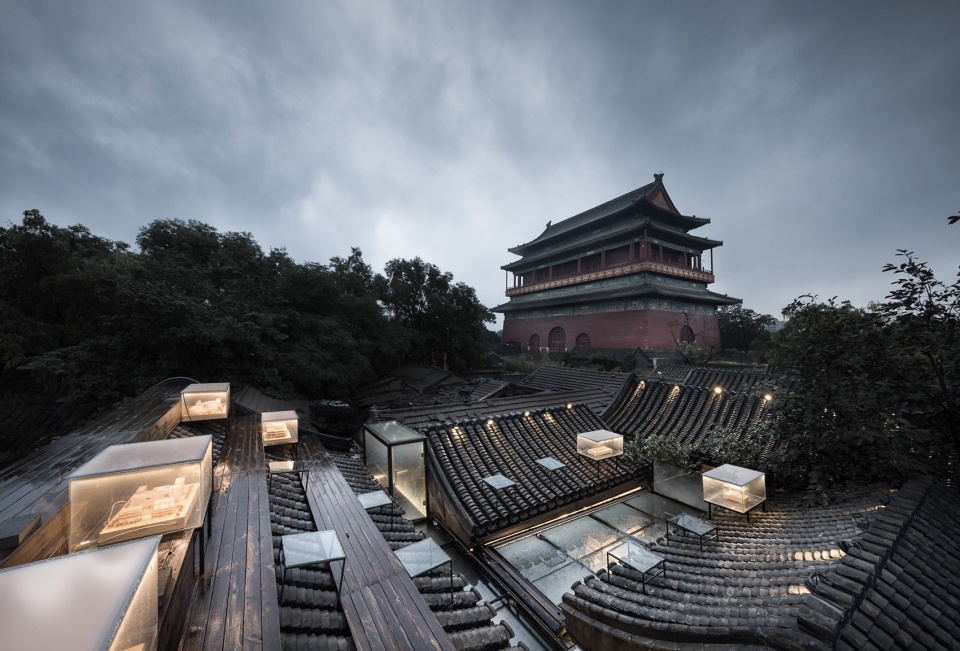
▼南眺鼓楼,Overlooking the Drum Tower to the south © BUZZ庄子玉工作室

▼屋顶模型展示,Model display on the roof © BUZZ庄子玉工作室
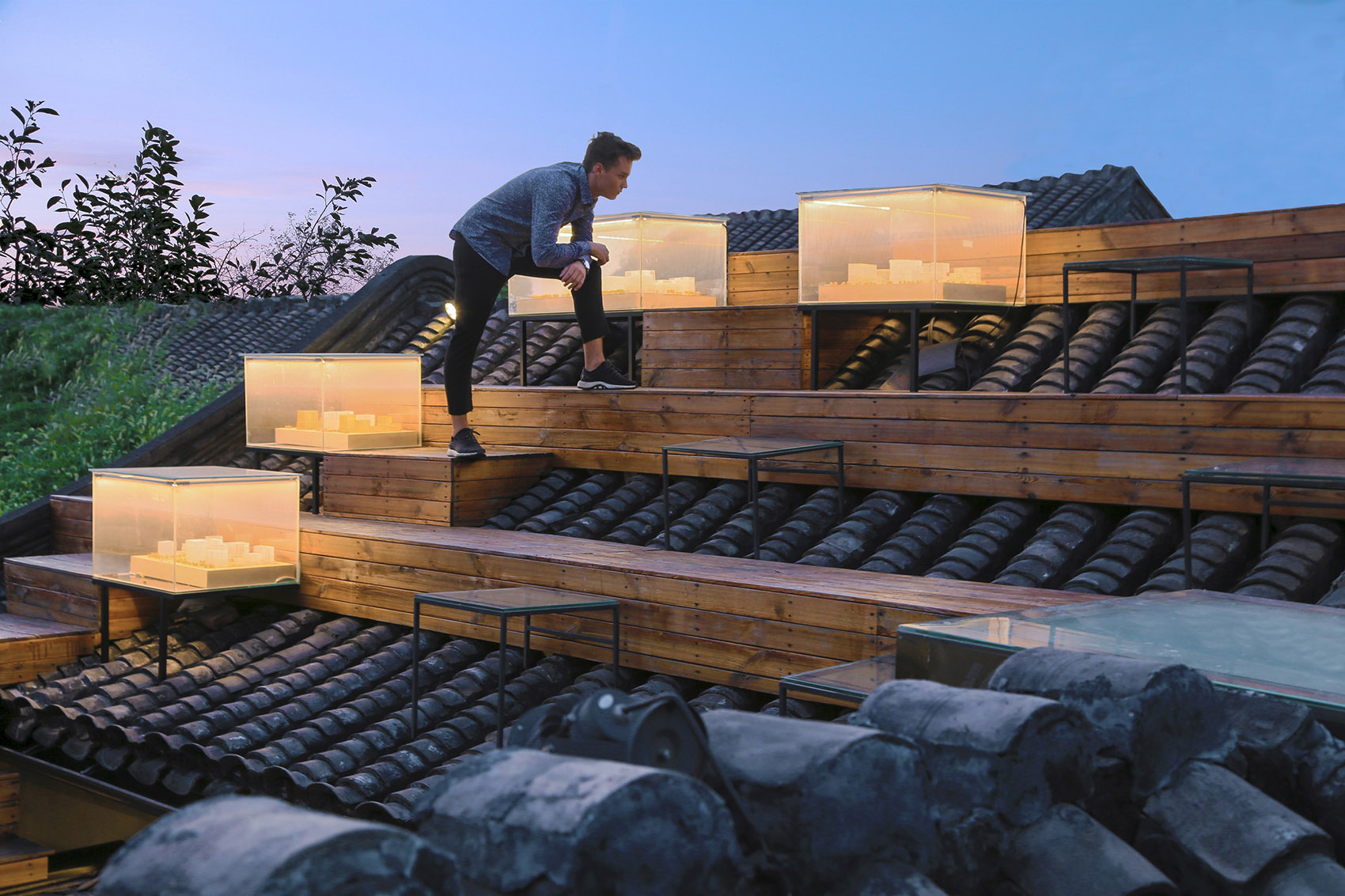
东轿杆,依形得名,是老北京最短也是最窄的胡同之一。院子位于胡同的最末端,恰好“跨”在了东城区与西城区的交界线上,占了西城区的地,借了东城区的墙。
Dongjiaogan Hutong, is one of the shortest and narrowest hutongs in old Beijing. The No.7 is located at the very end of the hutong, “straddling” the border between two administrative zones, occupying the land of Xicheng District and borrowing the walls of Dongcheng District.
▼鼓楼7号院对位及视线分析,Site analysis © BUZZ庄子玉工作室
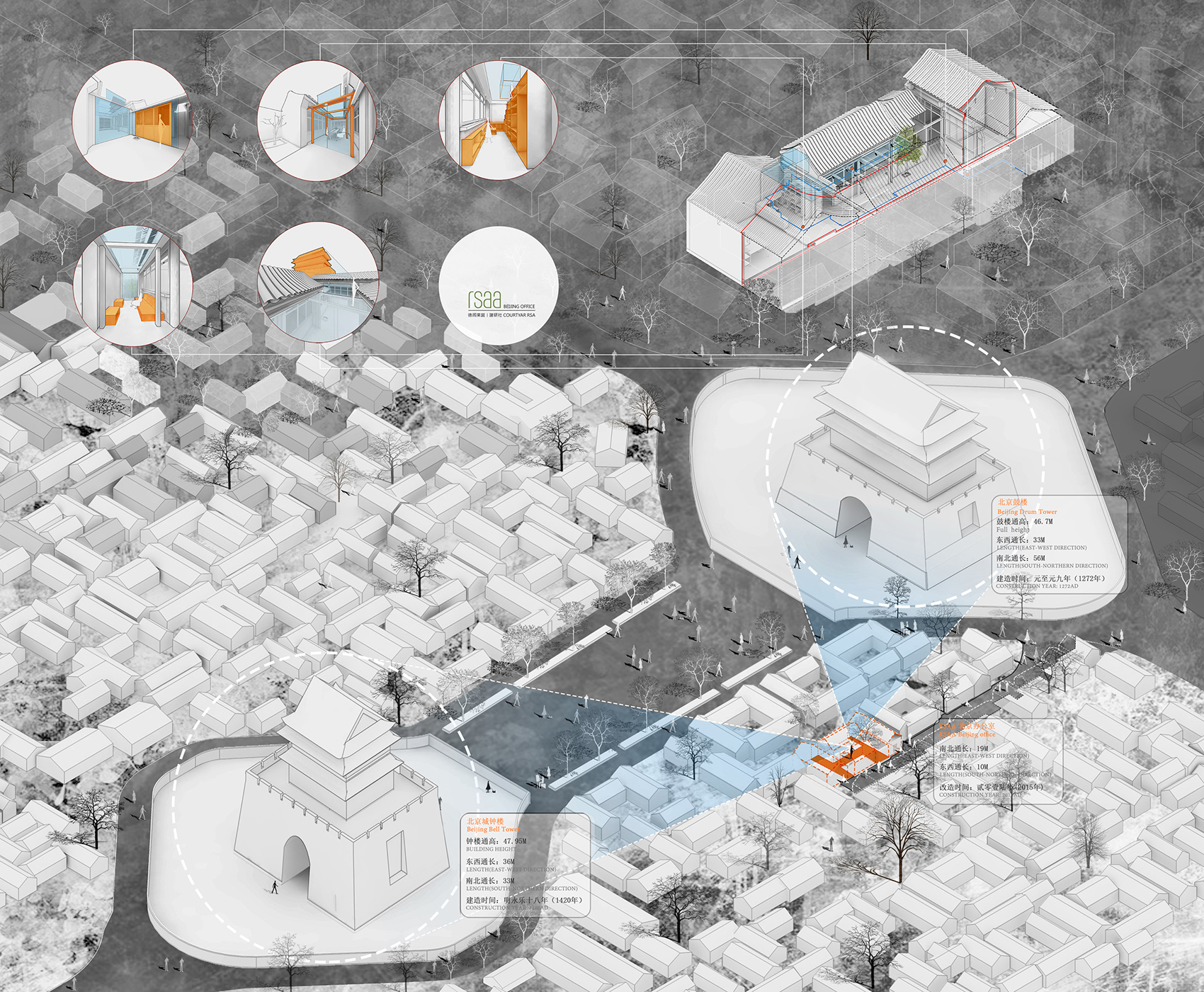
▼鼓楼7号院夜景 – 钟鼓楼对望关系,Night view: the Drum Tower faces the Bell Tower ©苏圣亮


院子的原主人是位年迈画家,与周边的杂院相比,7号院的的老建筑,在老画家的珍视下完整的保留了下来。
院子里有两棵树,一棵是柿子树,另一棵是腊梅。最初走进7号院的那天,天下着淅淅沥沥的小雨,钟楼的屋顶叠在北房的脊线后,鼓楼的倒影映在庭院的石板上,对7号院的改造方案,因此而生。
The original owner of the courtyard is an elderly painter, whose care has preserved the hutong in a much better shape than the surrounding yards. The patio features two trees, a persimmon tree and a plum.
▼入口,Entrance © 张辉
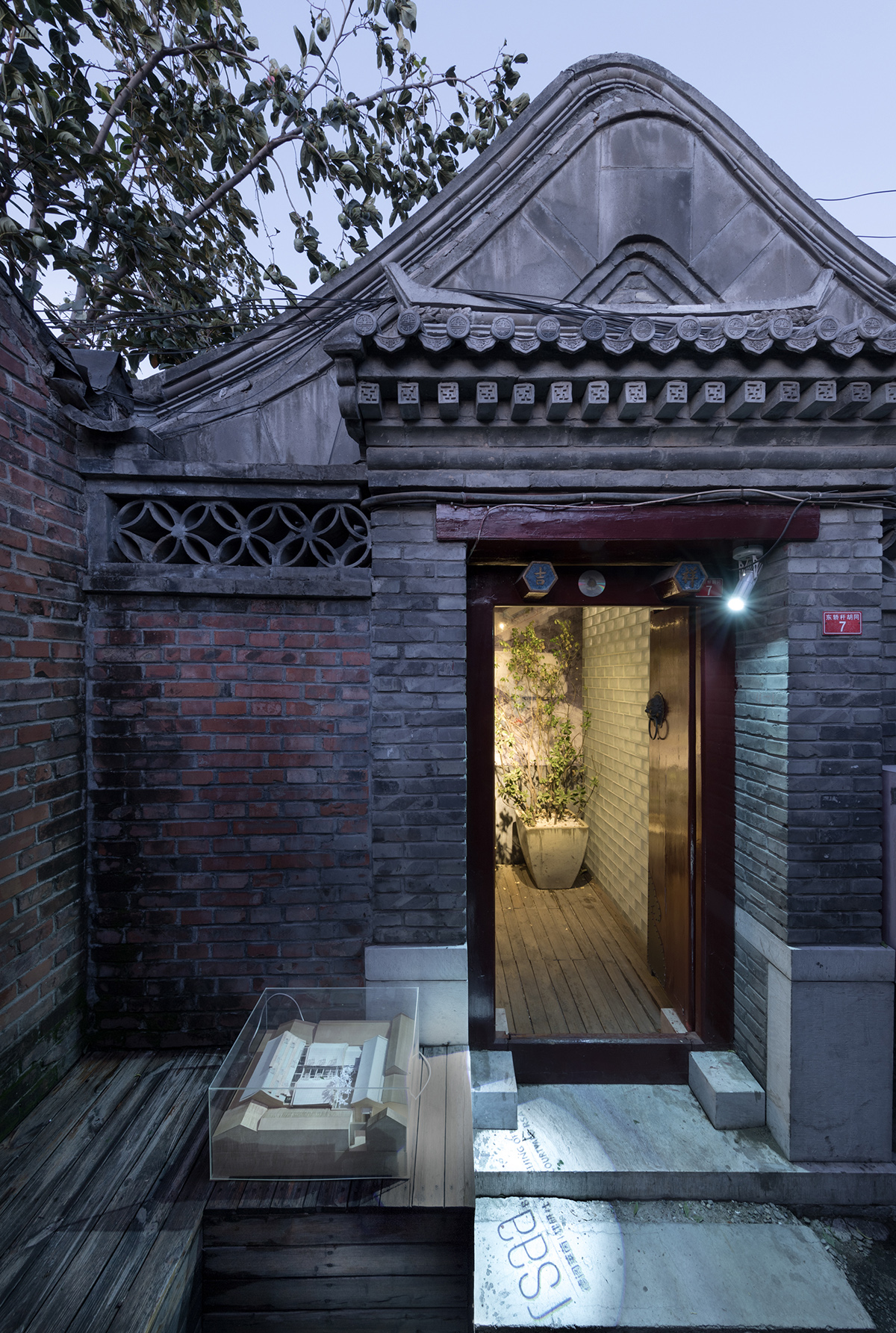

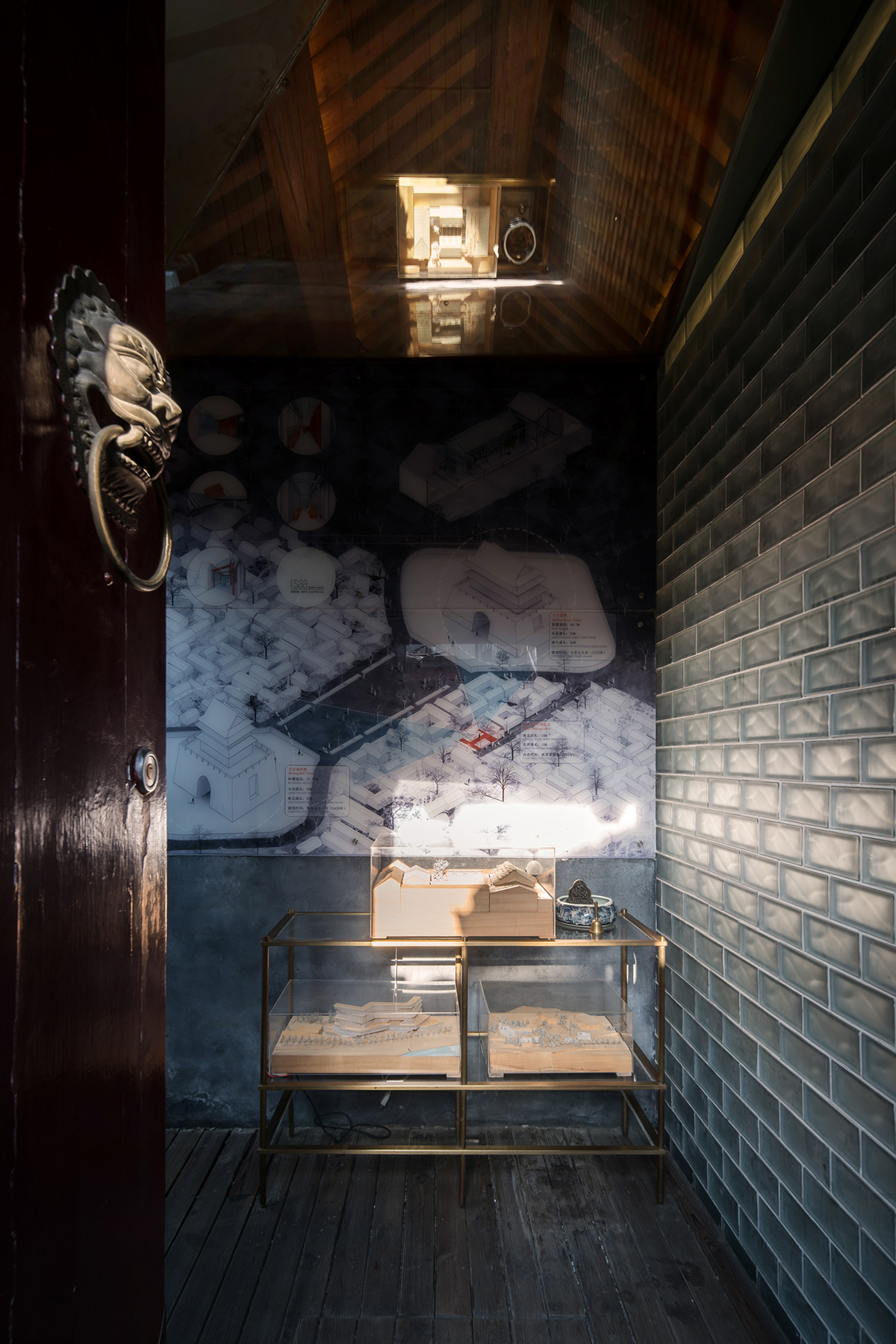
▼庭院,Courtyard © 苏圣亮


最初的设计目的,是在满足建筑事务所办公需求的同时,创造一种无时效的空间语汇以及对周遭空间文脉特征的引入和吸纳。因此,此次改造的方式被组织成了四个阶段:
1.以传统的工艺恢复/展示一些建筑的原有部分; 2.在此基础之上,植入一个“无时效的箱体”作为新生功能和空间的“发生器”; 3.在新的空间格局之下,重新处理内外一系列空间界面; 4.在新的界面的串联之下产生新的立体的空间序列。
The initial design objective was to create a timeless spatial vocabulary while meeting the office needs of an architectural firm, as well as to introduce and absorb the cultural characteristics of the surrounding space. Therefore, the approach of the renovation was organized into four phases:
1. Restoration and display of some original parts of the building with traditional techniques. 2. Introduction of a central box to connect and form new functions and spaces. 3. Following the new spatial pattern, several internal and external spatial interfaces are salvaged. 4. Creation of a new three-dimensional spatial sequence under the new series of interfaces.
▼路径与场景,The path and scenes © BUZZ庄子玉工作室
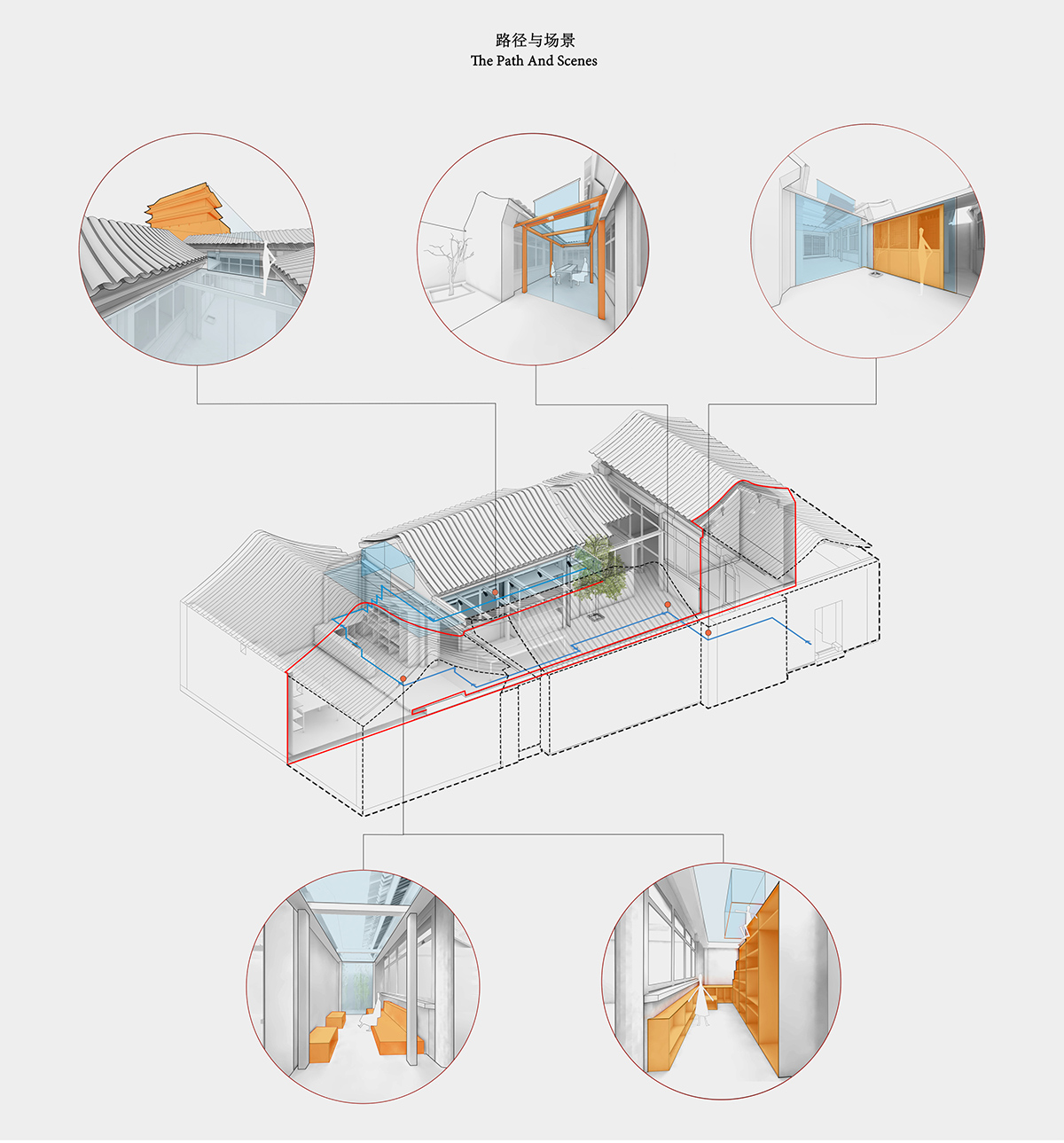
▼抬升后的视线关系,View after T yard lifted © BUZZ庄子玉工作室
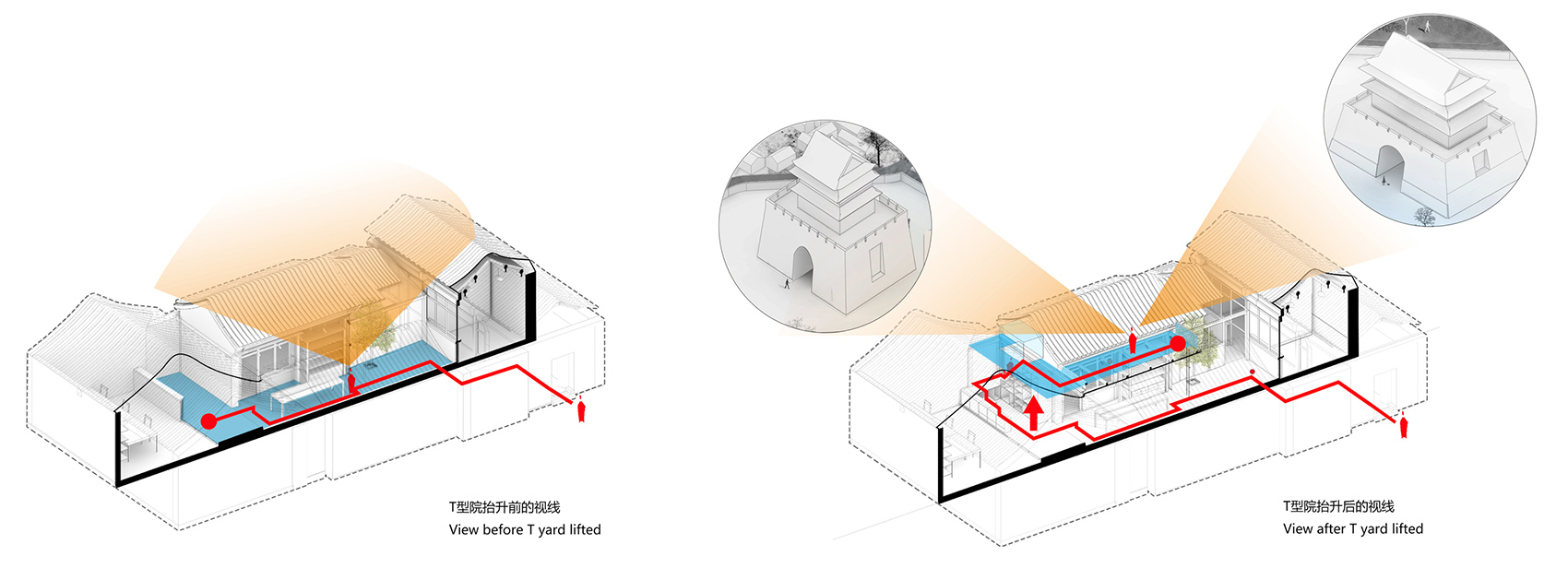
▼改造过程,Renovation process © BUZZ庄子玉工作室

为达成上述目的,设计在清除了部分不必要的装饰面并将原有的古建结构暴露出来后,在原有的工字型院落中,置入了一个自承重结构体系的玻璃体块,将北房东房西房作为连续空间联系起来,以获得更高的办公效率。
The start of this process was to remove the decorative elements and expose the hidden original structure. In a second step a self-supporting glass box was placed in the original I-shaped courtyard, linking the northern, western, and eastern rooms together to create a continuous space suited to the new office function.
▼功能分区及动线,Programme and circulation © BUZZ庄子玉工作室
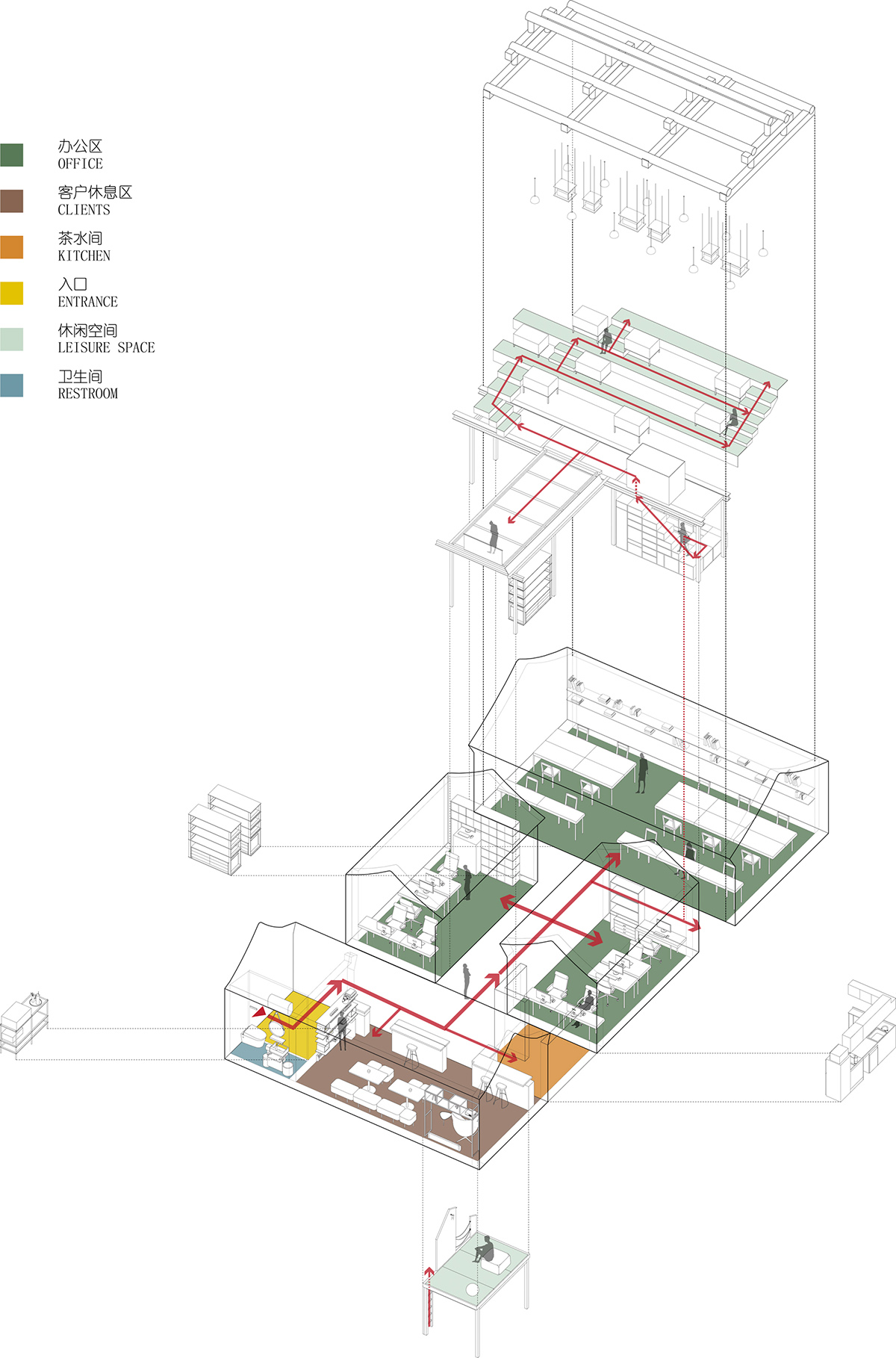
▼院内办公空间,Working area © BUZZ庄子玉工作室

在中国传统建筑中,屋顶形制及体量通常用于区分建筑等级,屋面本身从未被作为使用空间加以利用,仅檐下空间具备其相应功能。院中玻璃体块的加入,将从未被功能化的屋顶空间利用了起来。抬升后,原有老建筑的屋面与使用功能建立直接的联系,人的视野也得到了极大地拓展。钟鼓楼的距离,似乎也随着视线的抬升拉得更近,也更亲切。
In traditional Chinese architecture, the roof form and size are usually used to distinguish the building`s importance, but is not defined as a usable space itself, only the volume under the eaves has its corresponding function. The addition of the glass block in the courtyard introduces a new element and makes use of the roof space that has never been usable. It changes the way people move through the space, but also how existing parts are perceived: The distance to Drum and Bell Tower seems to shorten and the relation to become more intimate through the elevation of the eye level.
▼中国古建屋面迭代,Roof design from traditional Chinese architecture © BUZZ庄子玉工作室

▼院中玻璃体块的加入,将从未被功能化的屋顶空间利用了起来,The addition of the glass block in the courtyard introduces a new element and makes use of the roof space that has never been usable ©苏圣亮
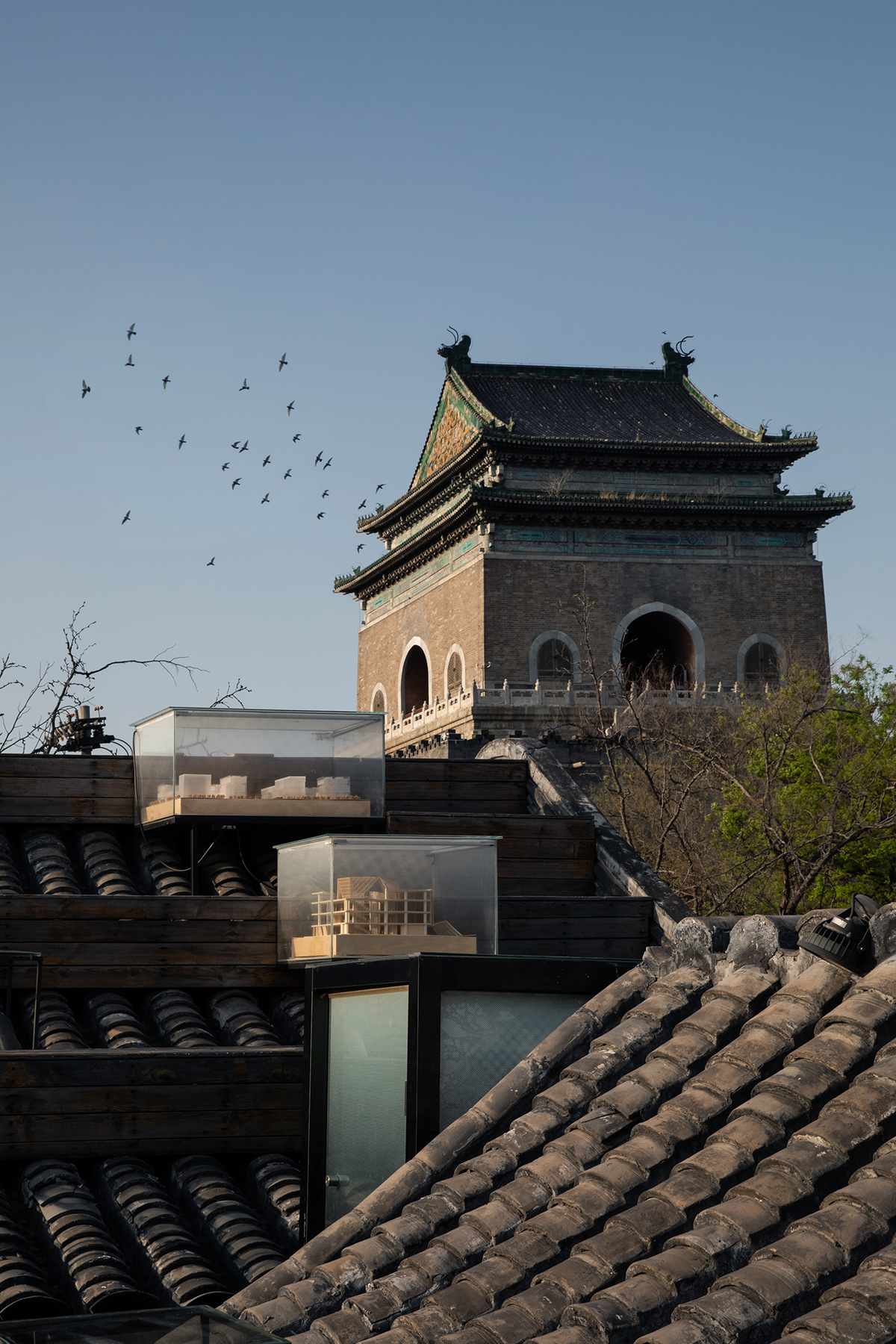
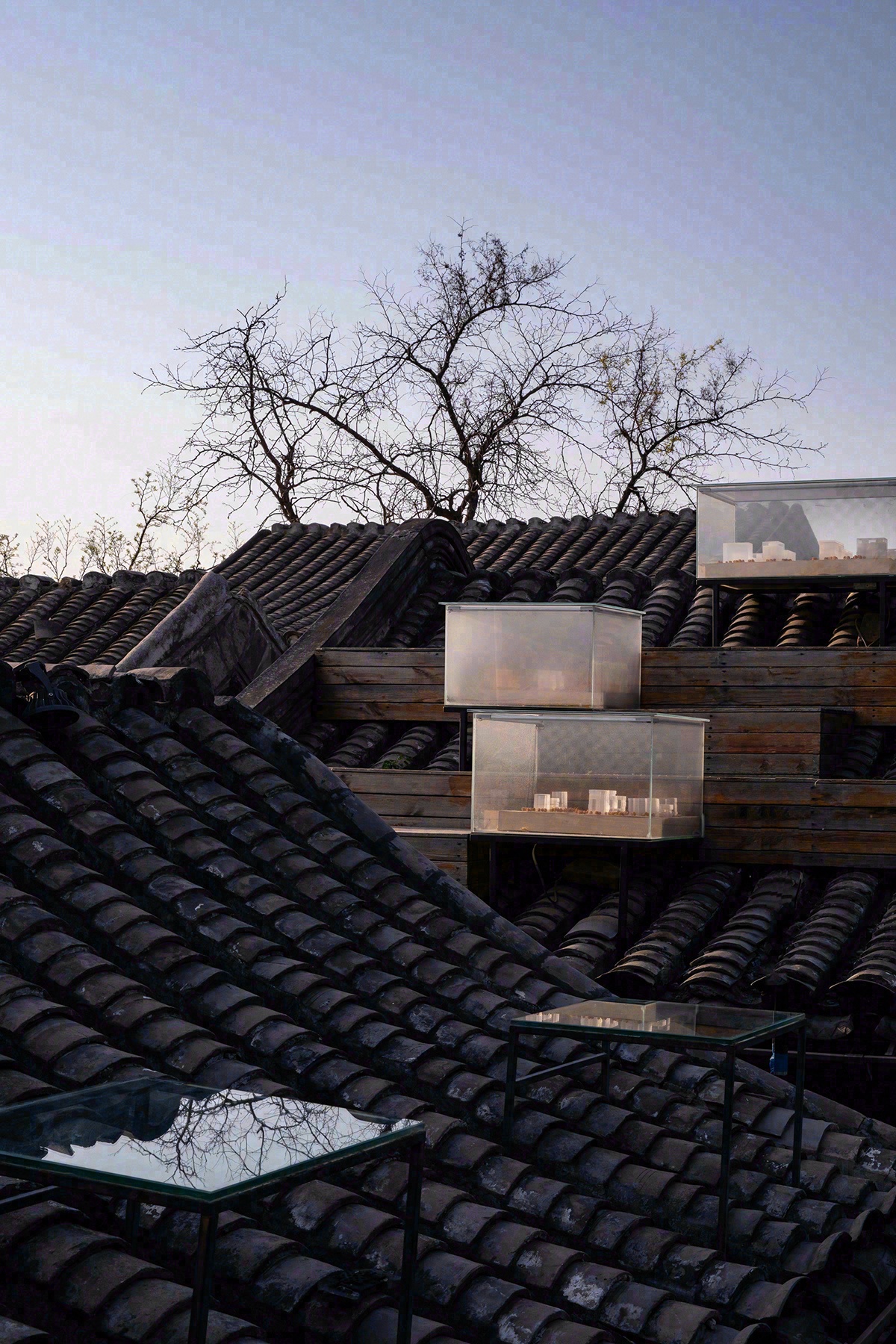
体块的顶部,成就了承载屋顶的公共活动的“T型台”,末端依旧可见南屋前露天的庭院,树上的柿子随之变得唾手可得。
The top of the box now forms a “T-shaped platform” for public activities on the roof, while the open patio in front of the southern room is preserved. The identity giving persimmons on the trees become readily available and can now be plucked without a ladder.
▼屋顶空间,Rooftop view © BUZZ庄子玉工作室
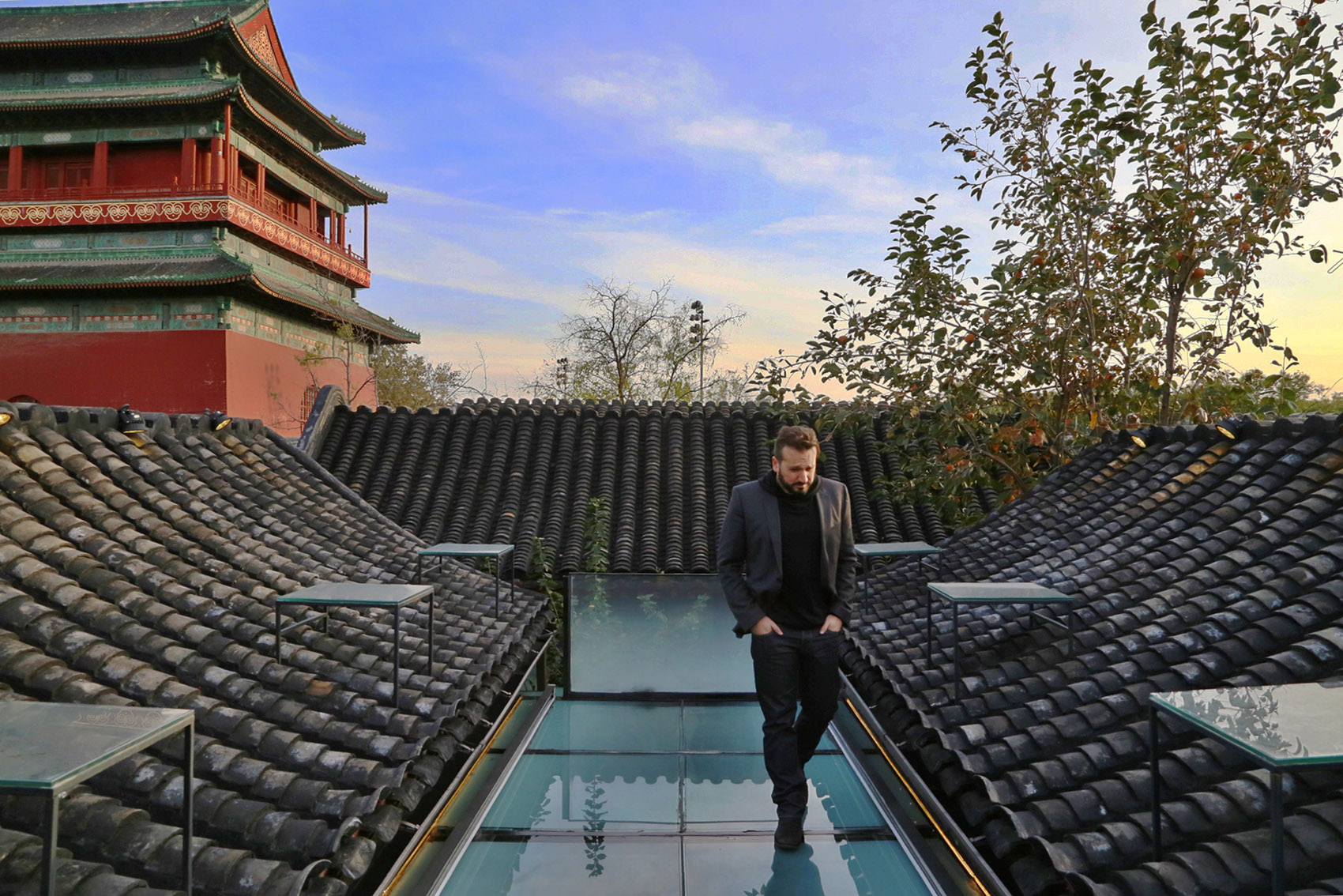
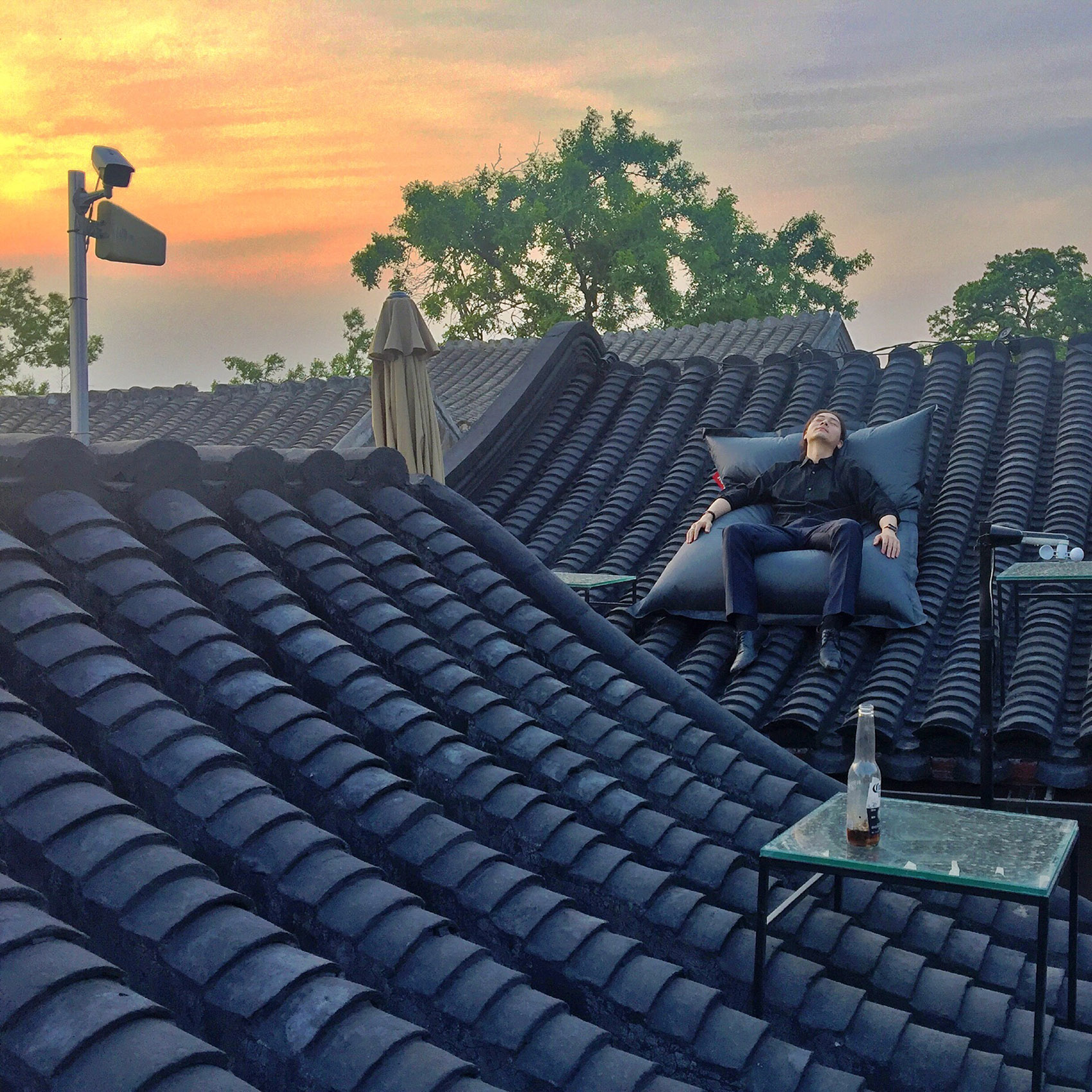
玻璃顶下原有的庭院,变成串联起三个办公空间的共享展示区域,东北角增设一个了综合书柜同时充当了通向屋顶平台的楼梯。由于胡同条件限制,室外机被巧妙集中在工字院西北角的半透明的光井之中,配以人工绿植及磨砂玻璃,反而成为新的视线焦点。
Below the glass roof a shared display area links the three office spaces, and a custom bookcase has been added in the northeast corner to serve as a staircase to the roof deck.
▼共享展示区域,Shared display area ©苏圣亮
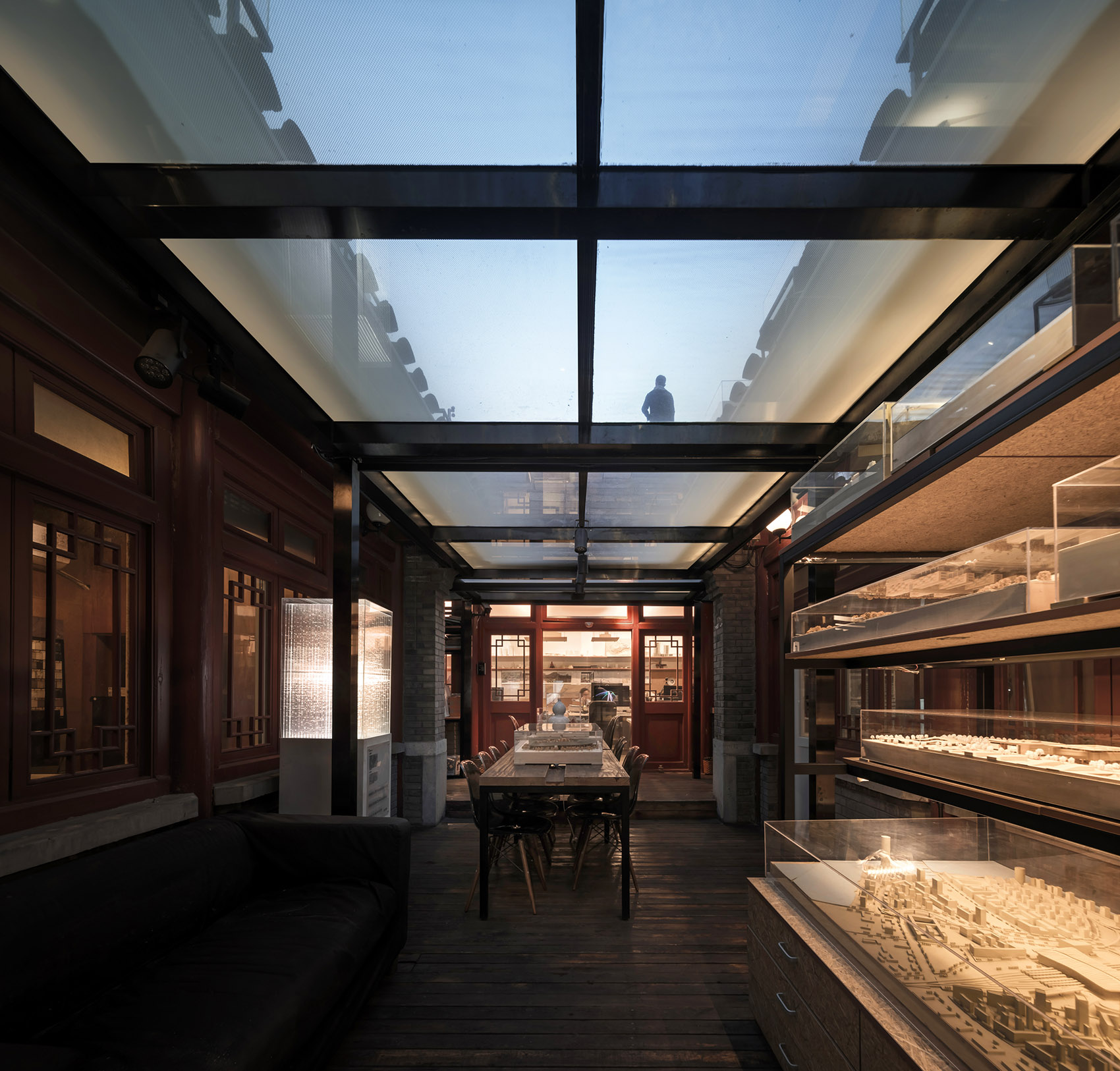
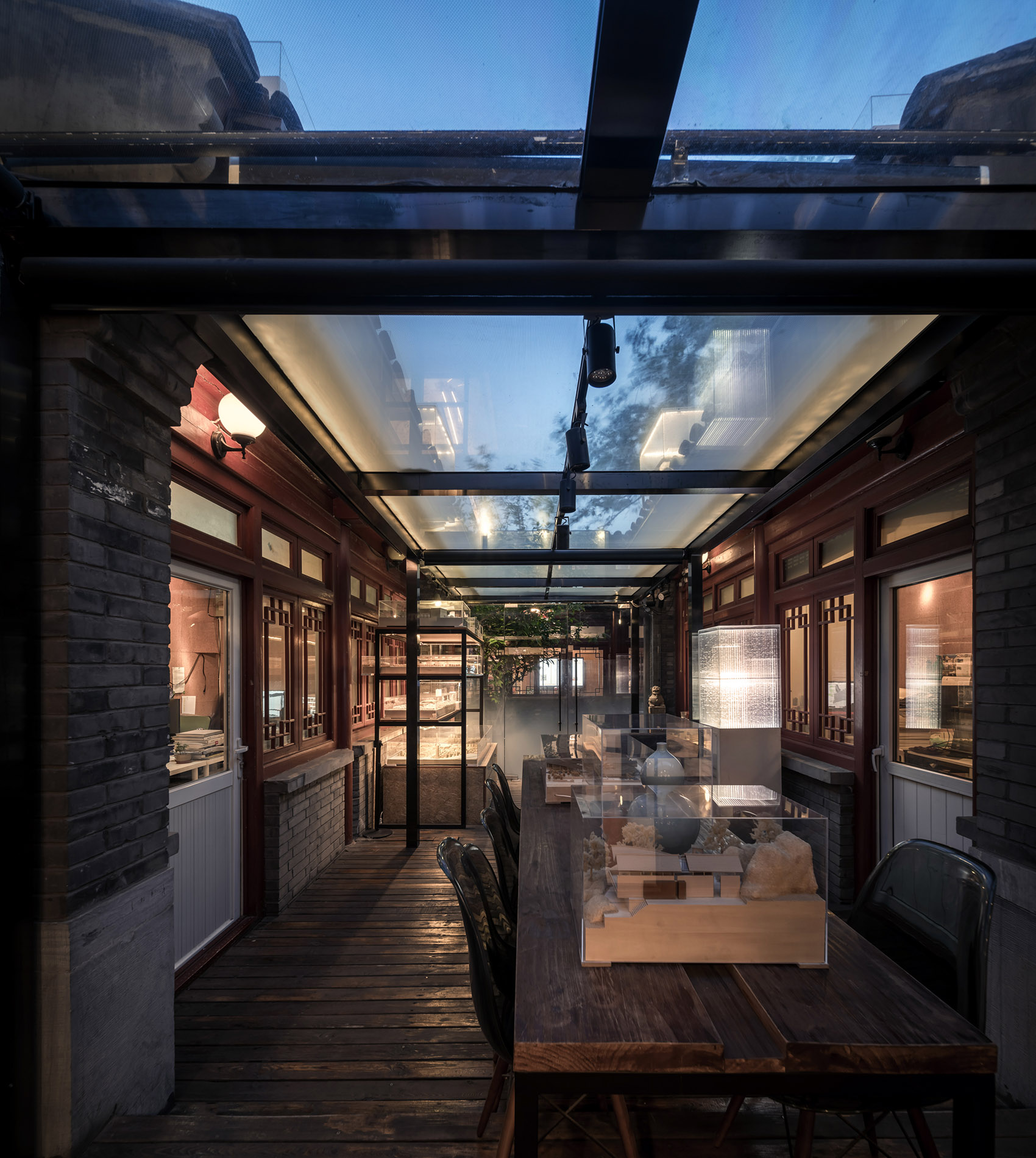
▼钢结构中庭,Steel structure in the atrium © BUZZ庄子玉工作室
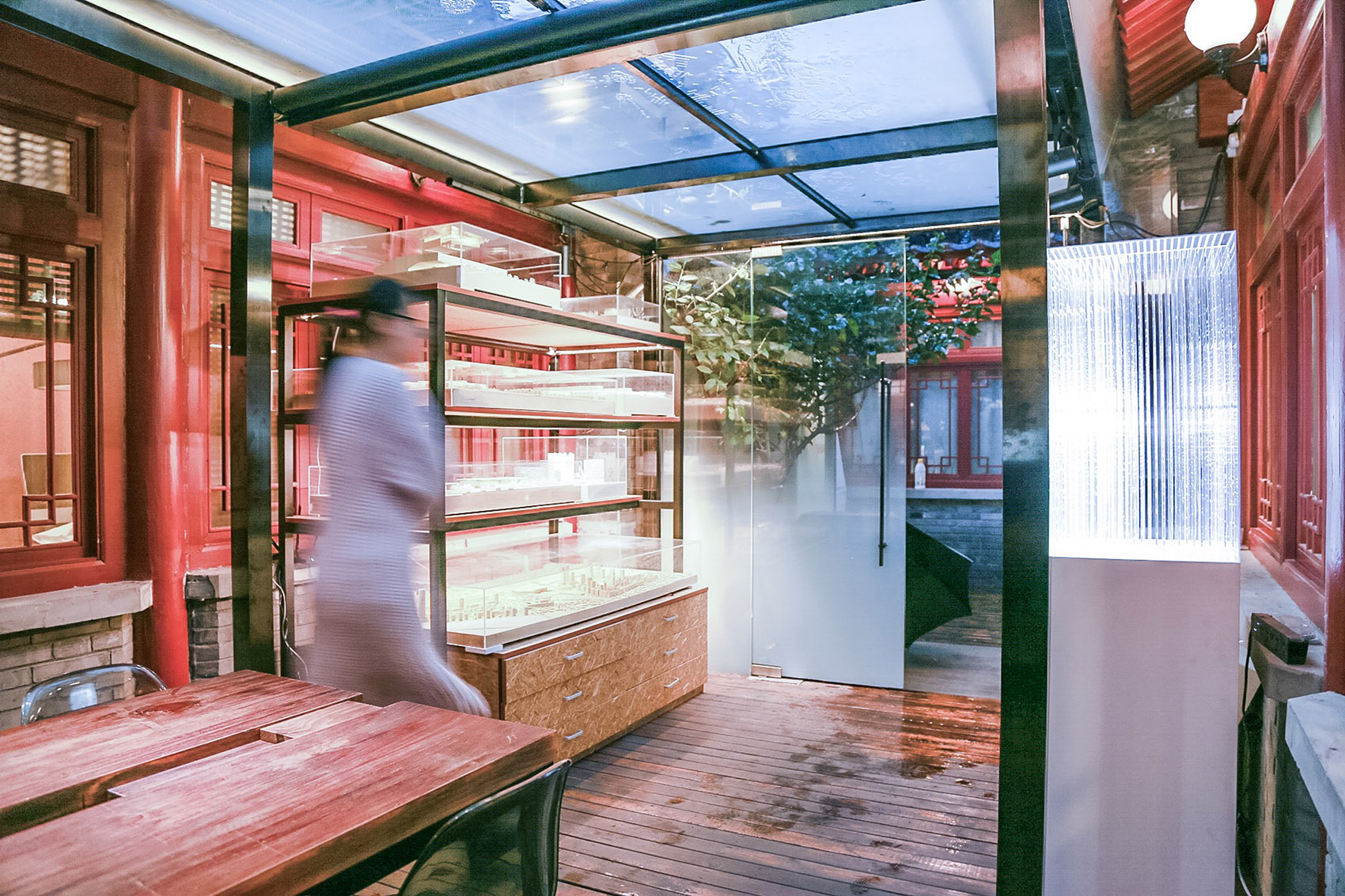
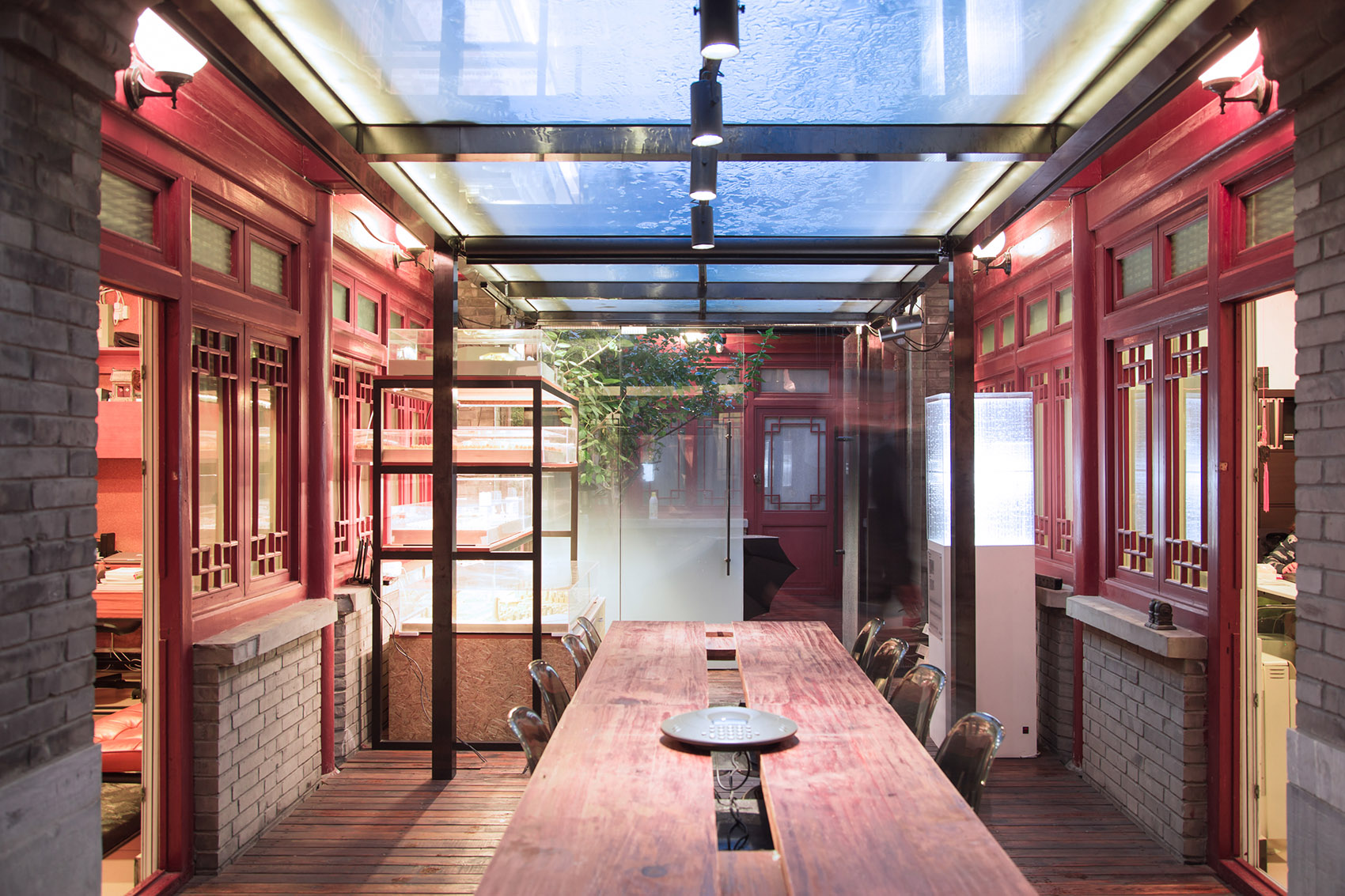
▼东北角书架及楼梯,Book shelf and stairs © BUZZ庄子玉工作室
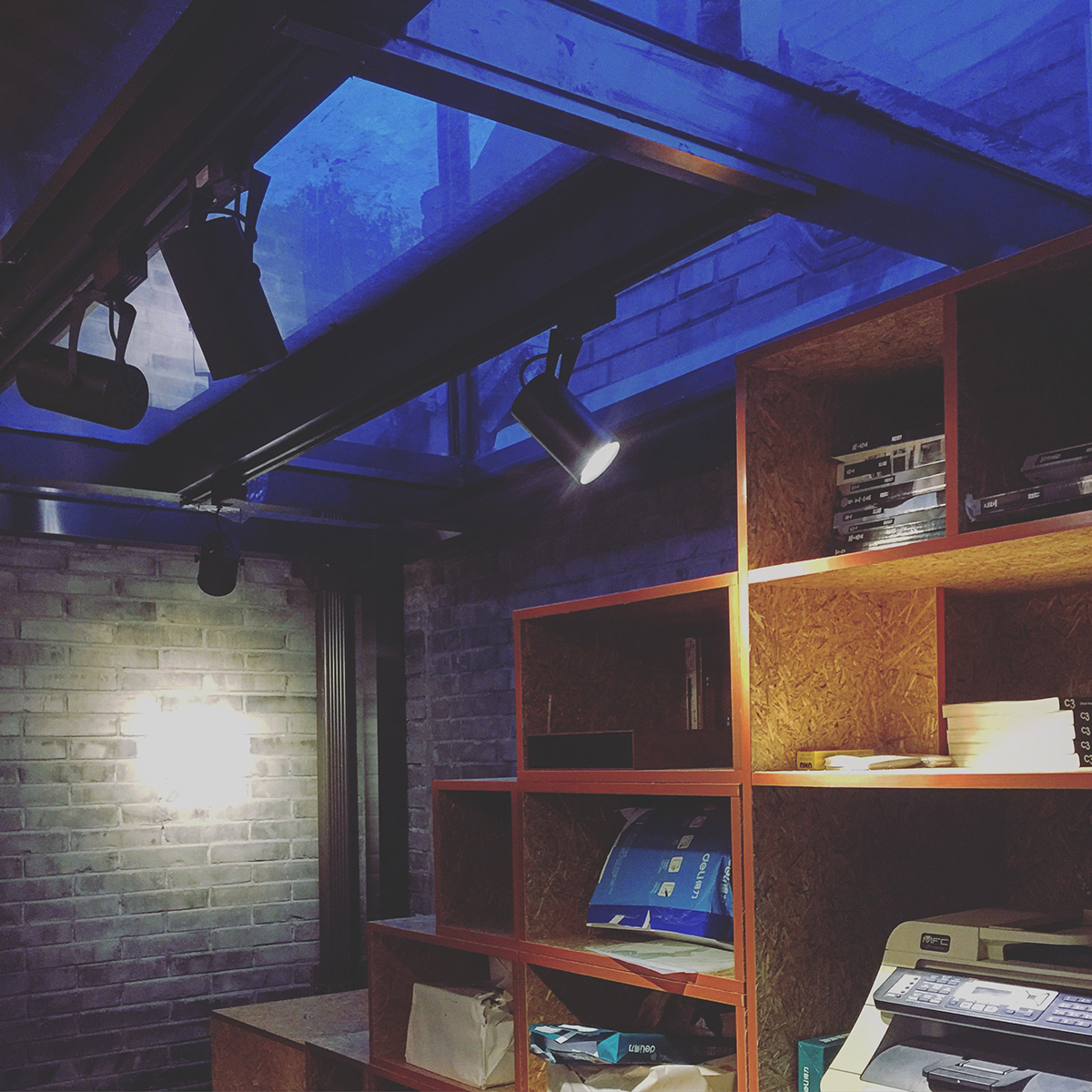
▼西北角材料展示区,Material display area © BUZZ庄子玉工作室
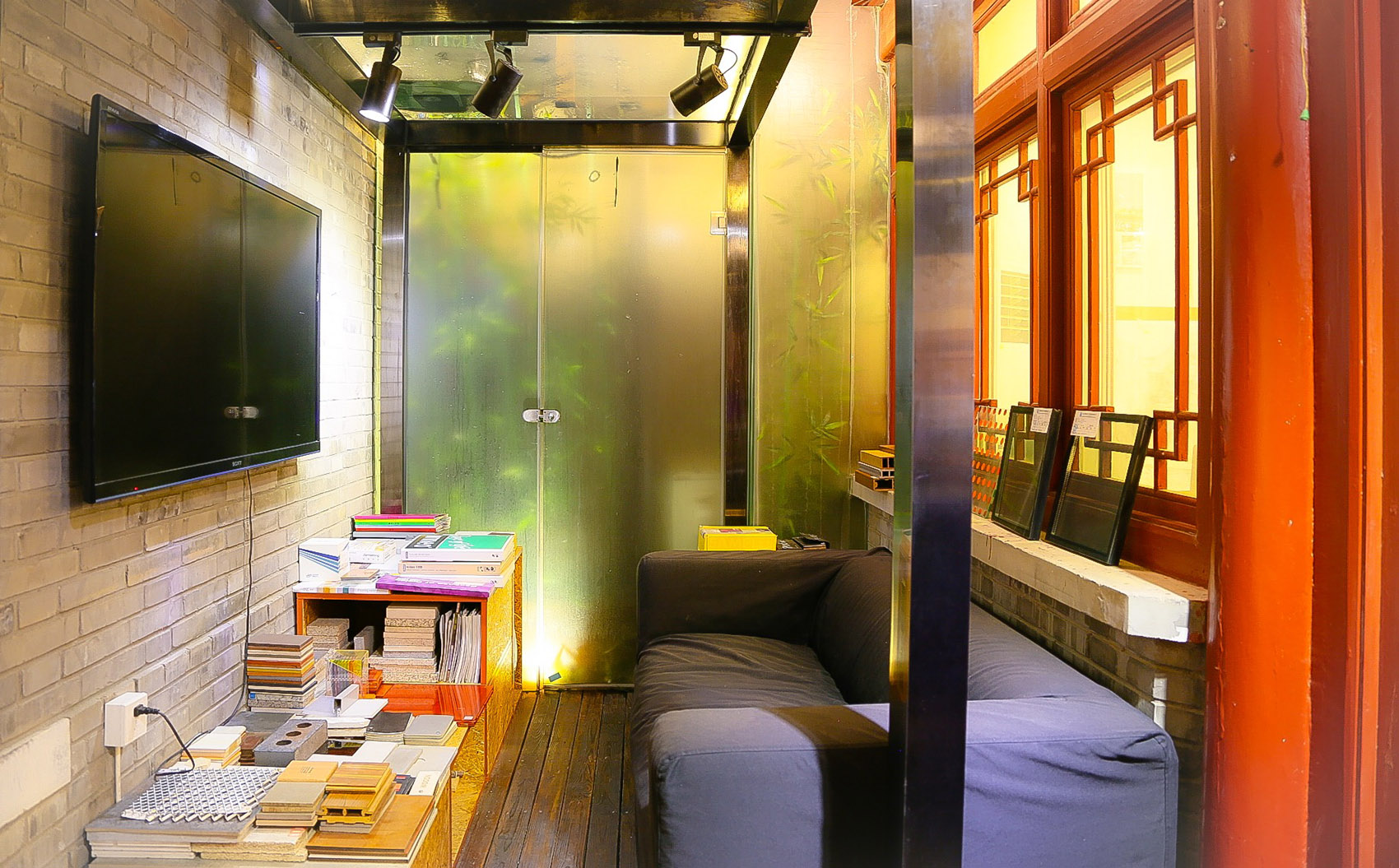
▼庭院细节,Detailed view © BUZZ庄子玉工作室

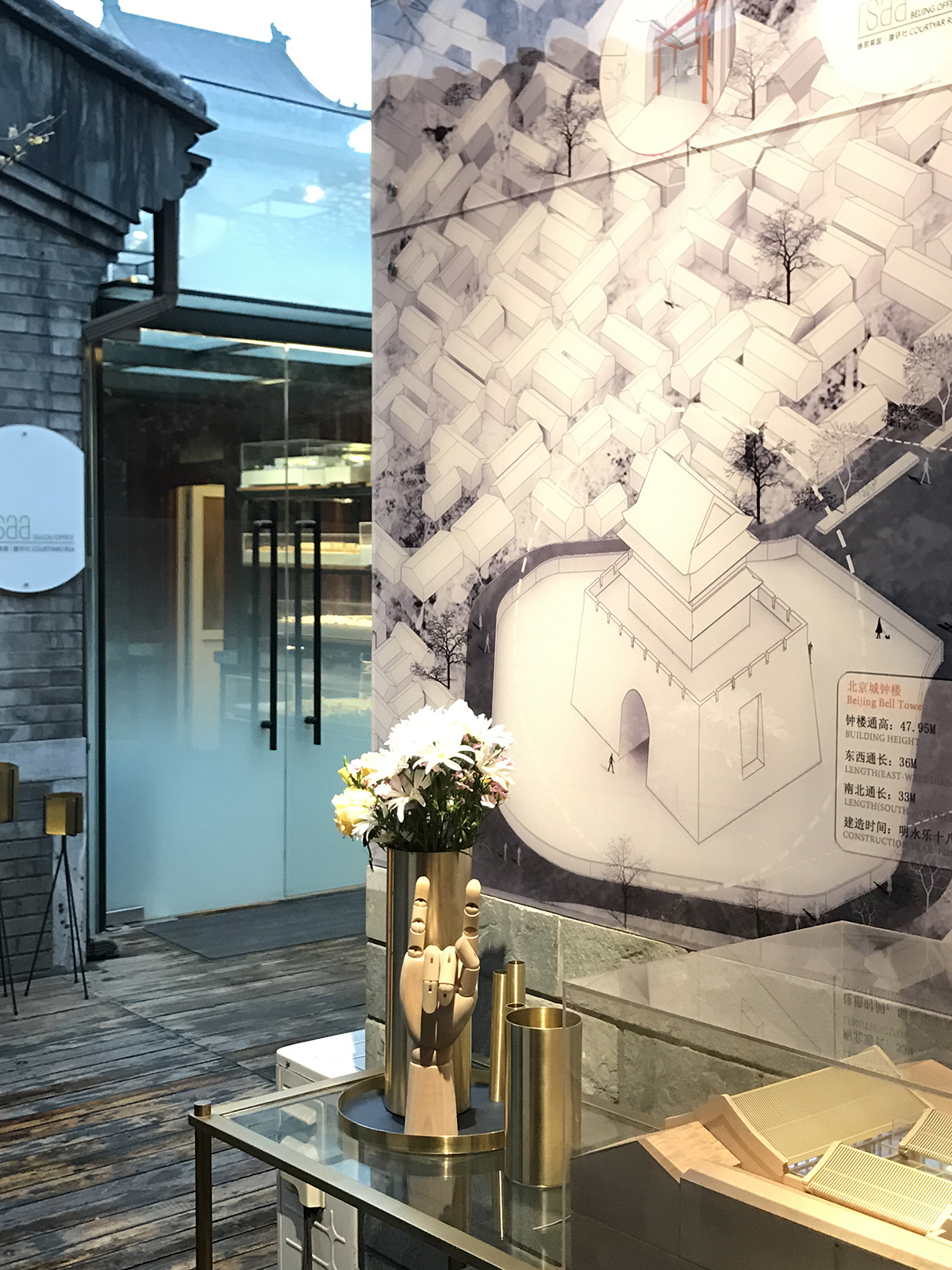
二期改造中,屋顶被做成更永久性的状态,在建筑现有的椽子的部分进行了加固并搭建了龙骨,形成了阶梯的状态,与传统的屋面的互动自此呈现出一个量变到质变的过程,和人的行为直接连接起来。
In the second phase of the renovation, the roof was made more permanent by reinforcing the existing rafters of the building and adding benches to create a stepped topography that allows for a more immediate interaction with the traditional roof.
▼屋顶改造示意,Roof renovation diagram © BUZZ庄子玉工作室
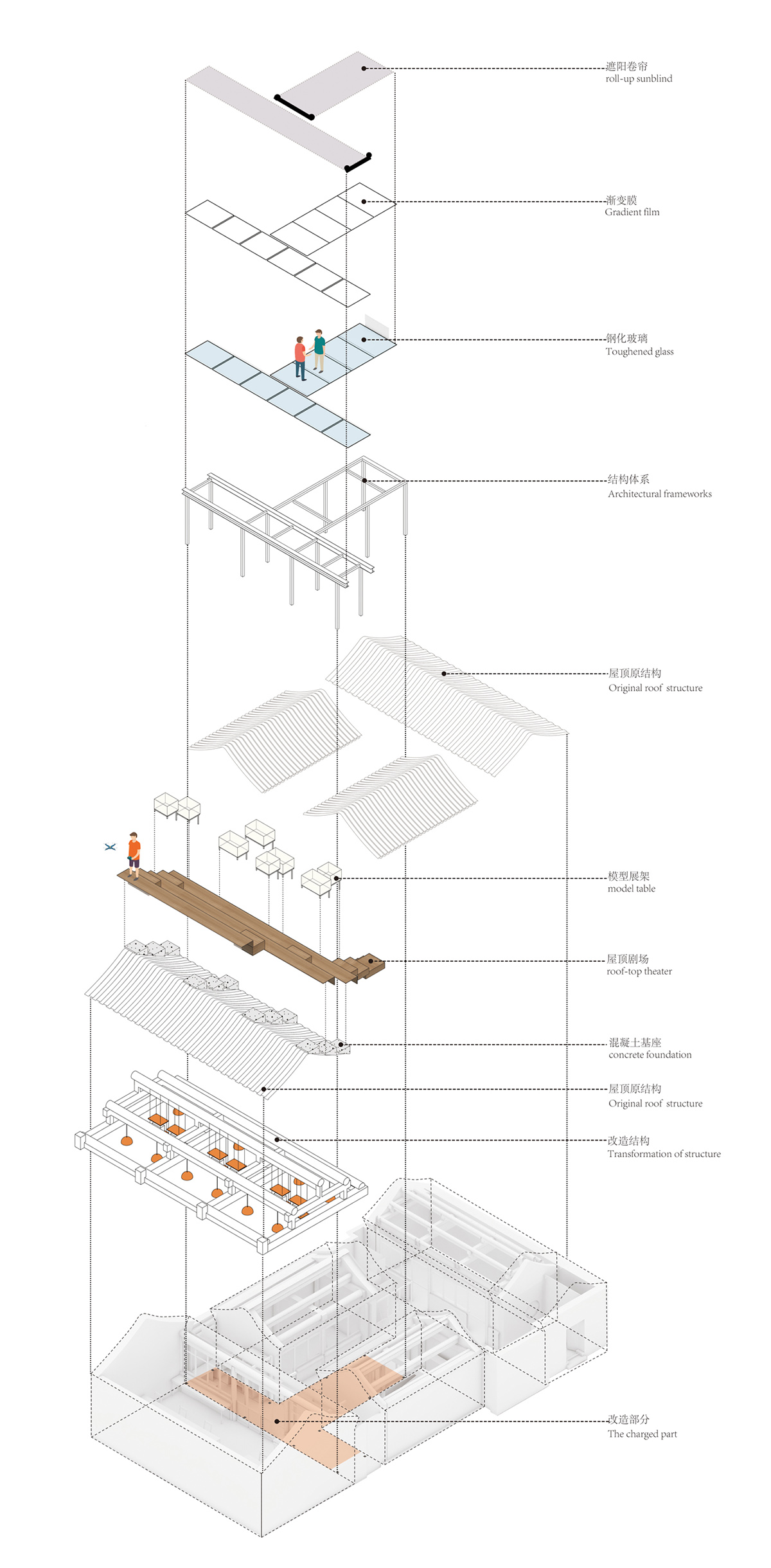
工作室的建筑模型,被置入一个个玻璃灯箱中,打破了阶梯的横向元素,也点亮了屋顶的公共空间。屋顶下的挑高空间也被充分利用,入驻时的石膏吊顶被拆除后,原有木构形式被再次打开,上层空间被若干个箱体及反射面所占据,作为模型展示之用,与外露的建筑结构相得益彰,同时也潜在传递出以建构文化为先导的设计理念。
The architectural models of the studio are on display in lightboxes that break the horizontal lines of the modifications. The resulting landscape offers a communal space to seek inspiration, surrounded by the studios past as well as Beijing’s history. Below the roof the original wooden construction of the roof is further exposed and made visually accessible.
▼玻璃灯箱点亮了屋顶的公共空间,Glass boxes light up the public space on the roof © 苏圣亮
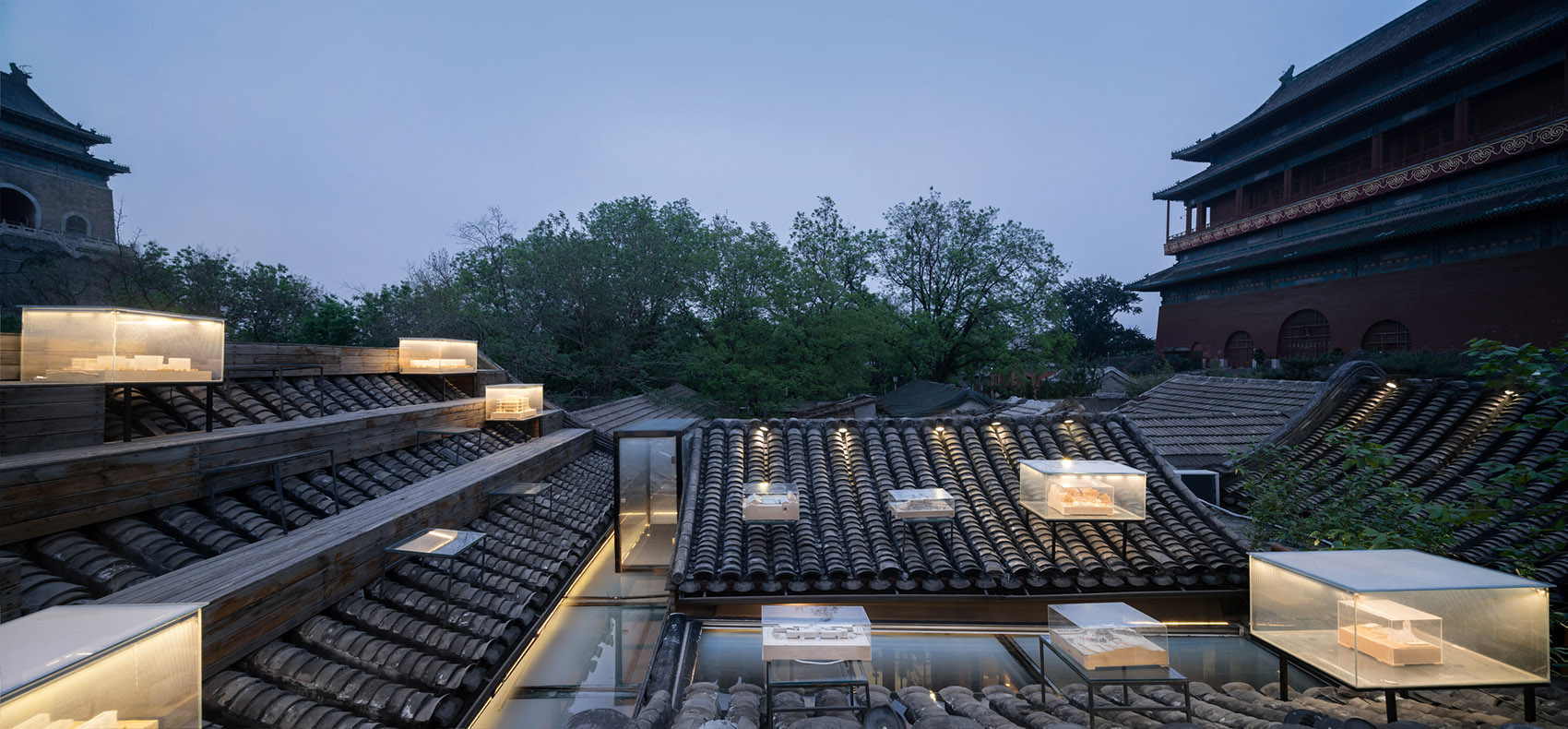
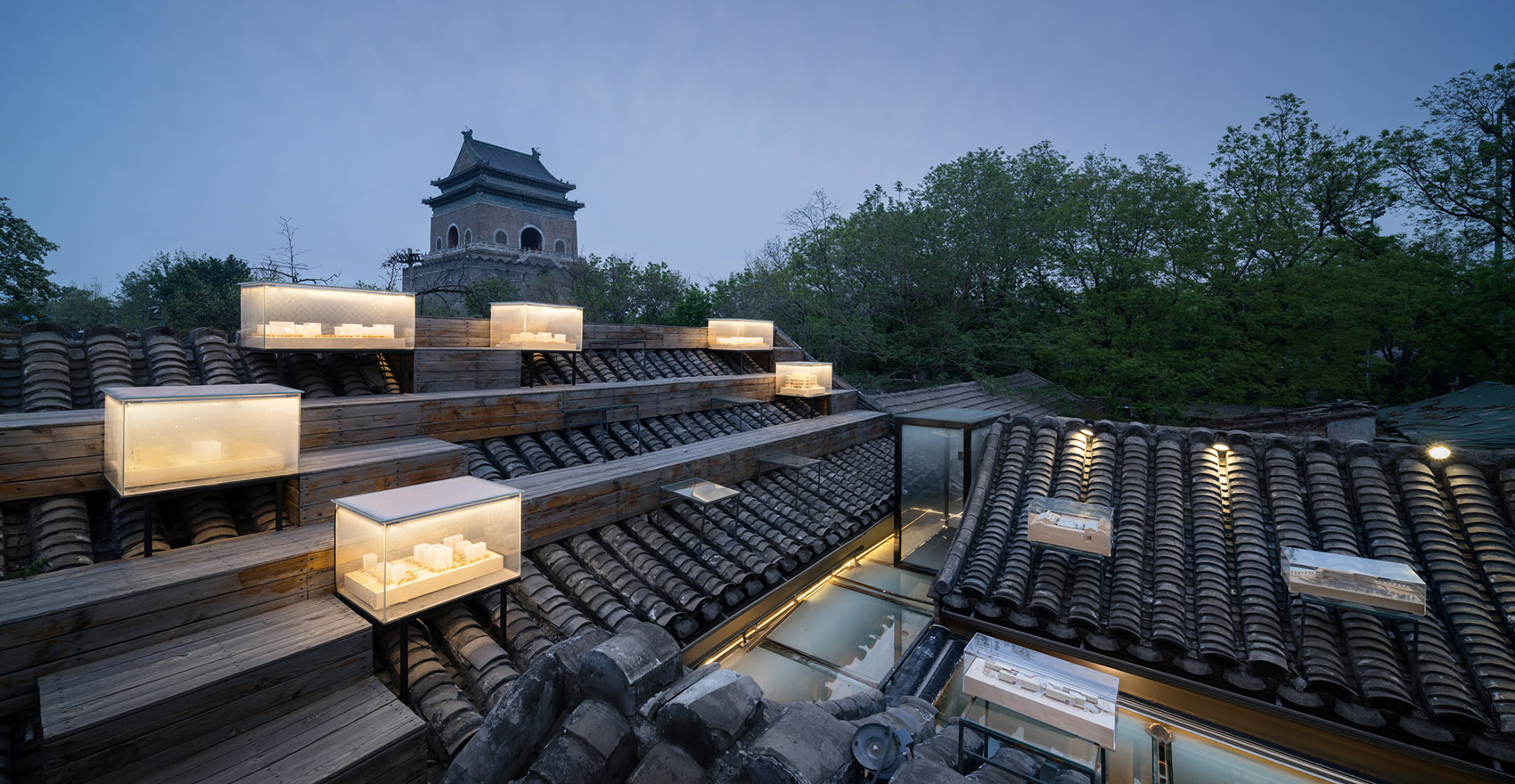
▼屋顶夜景,Roof by night © BUZZ庄子玉工作室
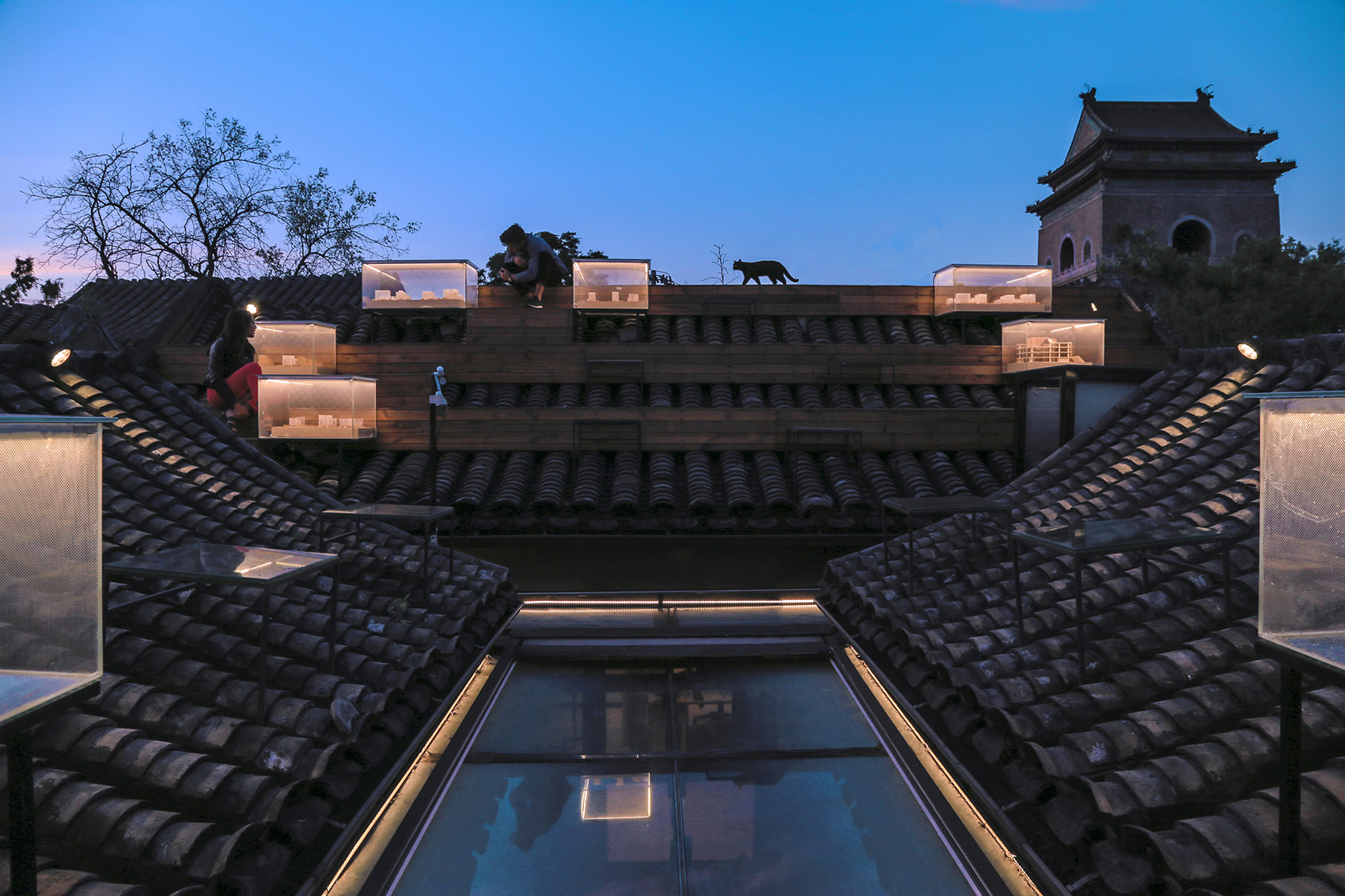
三期改造是针对南屋功能的调整,意在打造一个开放的放松的公共空间,也将充当未来扩充团队的载体。厨房改造利用隔壁院落的外墙(灰色)以节省材料,同时将原有结构部分(红色),表面瓷砖(绿色)重新加以利用,形成新的室内空间。
In the third phase of the renovation the southern room was refurbished to create an open and relaxing common space that could also serve as a breathing room for future expansion of the team. The kitchen renovation utilizes the exterior wall (gray) of the next courtyard to save materials, while reusing the original structural part (red), and surface tiles (green) to form a new interior space.
▼会议及公共空间,Meeting space ©苏圣亮
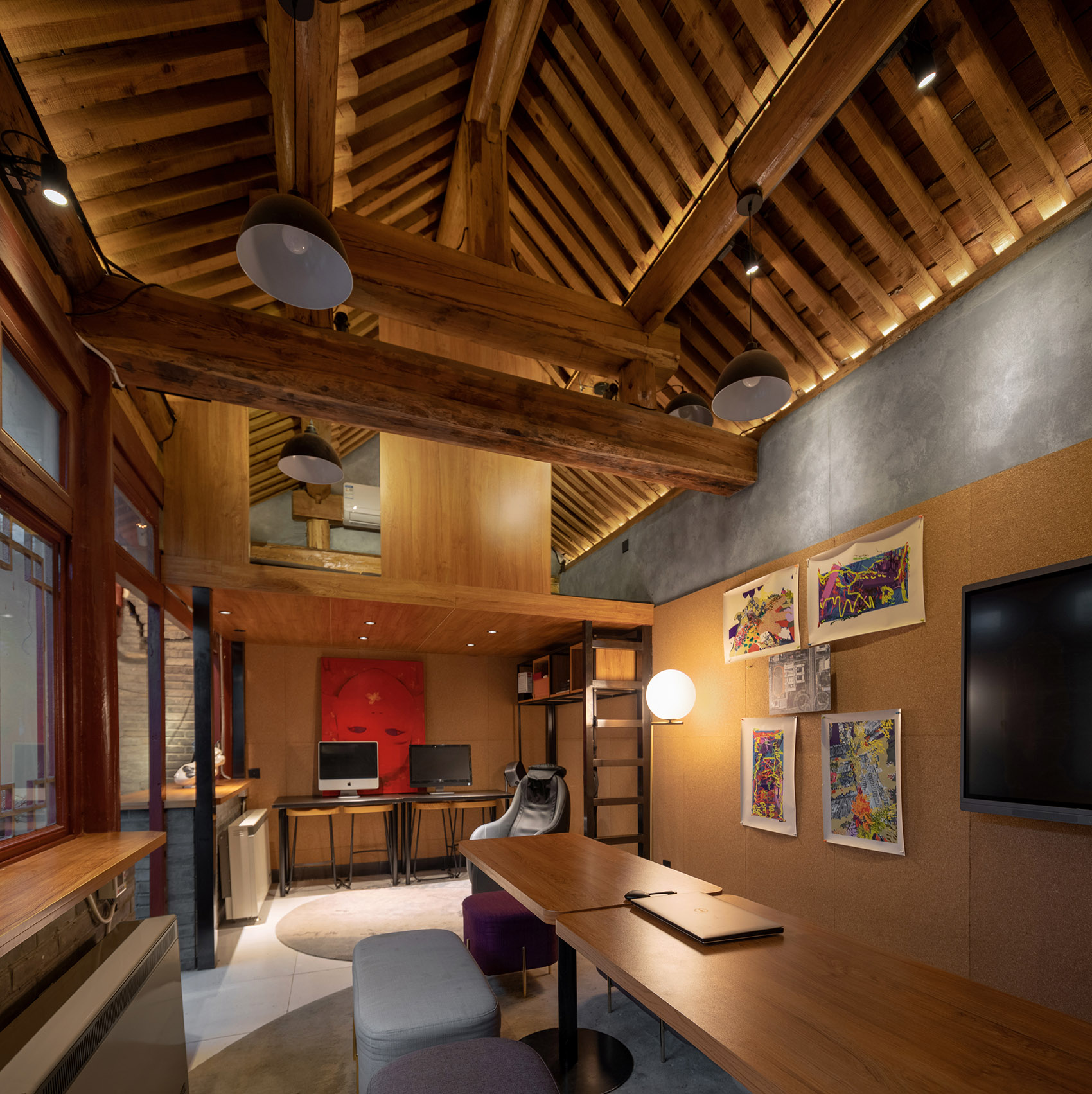
▼工作空间,Working space © 苏圣亮
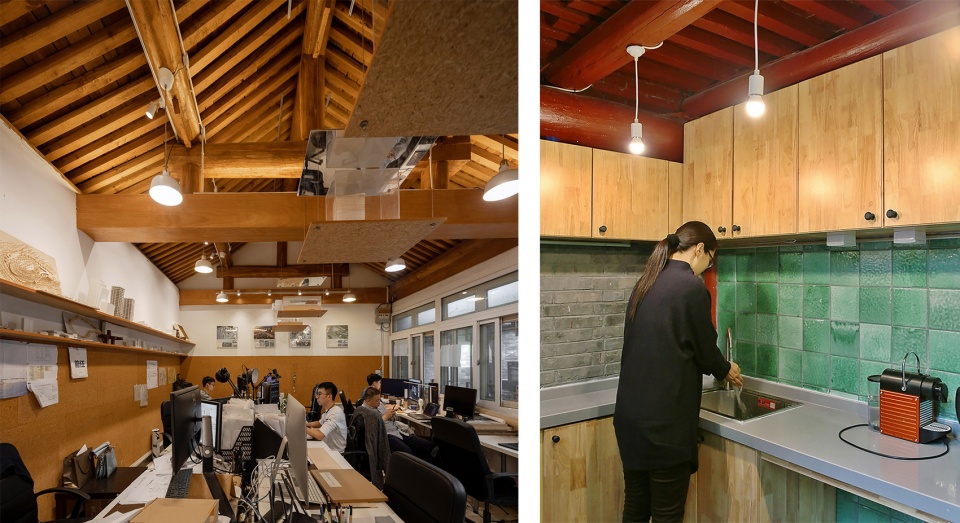
▼细节,Detailed view ©苏圣亮
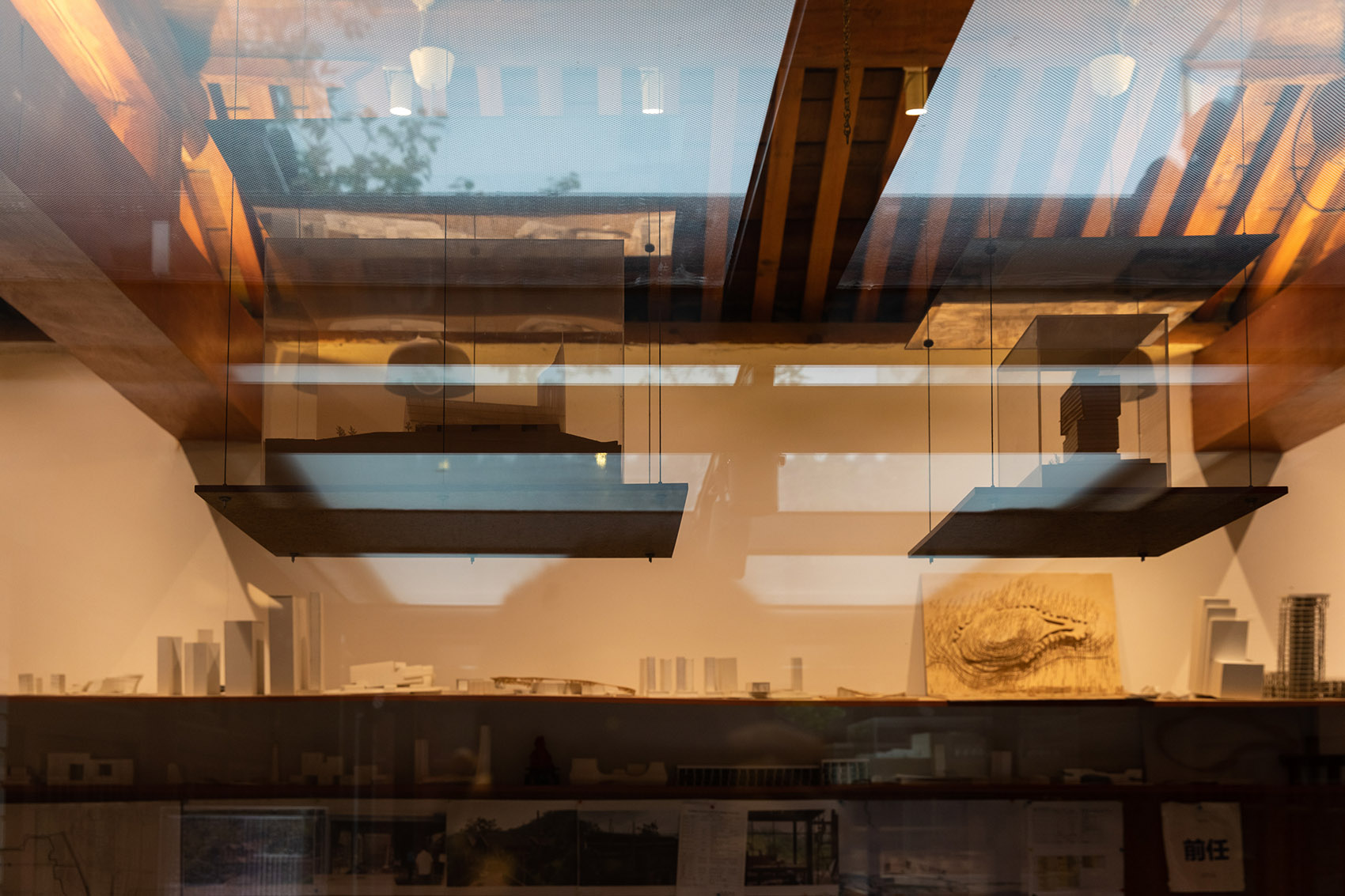
7号院的改造,将传统一进院空间的单一界面进行了重新组织,在一系列的空间曲折与序列之上,创造了若干新的空间节点的可能,在相对低成本的条件下融合了传统和当代的精神。
The renovation of No. 7 courtyard reorganizes the traditional spatial concept of a Chinese courtyard, adding new spatial nodes on top of a series of new rooms. Traditional and contemporary spirits are fused under relatively low-cost conditions.
▼院中光影,Light and shadows © BUZZ庄子玉工作室
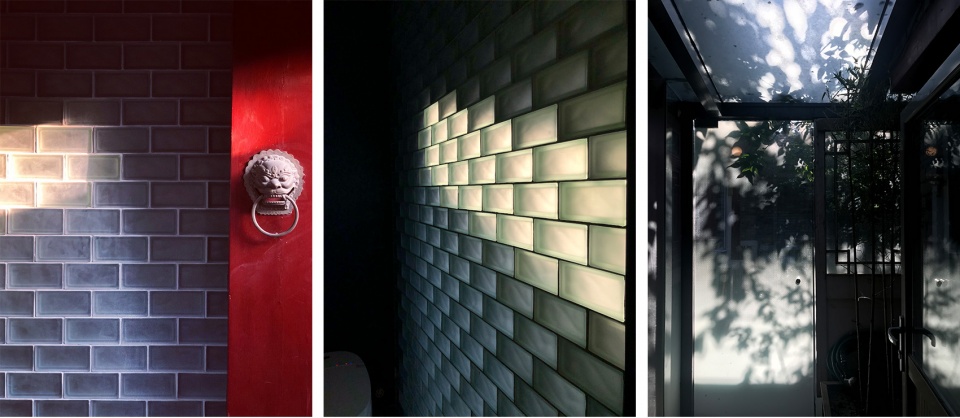
▼天花细节,Ceiling detail © 苏圣亮

鼓楼7号院的改造过程,是一个类似中国传统造园的方式。设计者也是使用者,将自身置身于环境之中,在长期参与体验、参与使用,对空间不断改造、不断观察、不断调整的过程中,也将7号院作为一个体验的容器,随着对院子认知和体验的更新,不断变化对空间营造的动作。
This transformative process of renovating Gulou No. 7 courtyard resembles traditional Chinese gardening. The designer is also the user, placing himself in the environment, and in the process of participating in the experience and use over time, constantly transforming, observing, and adjusting the space. The designer also uses No. 7 courtyard as a container for experience, constantly changing the action of creating the space as his perception and experience of the courtyard is transformed.
▼屋顶活动,The roof during an event © BUZZ庄子玉工作室
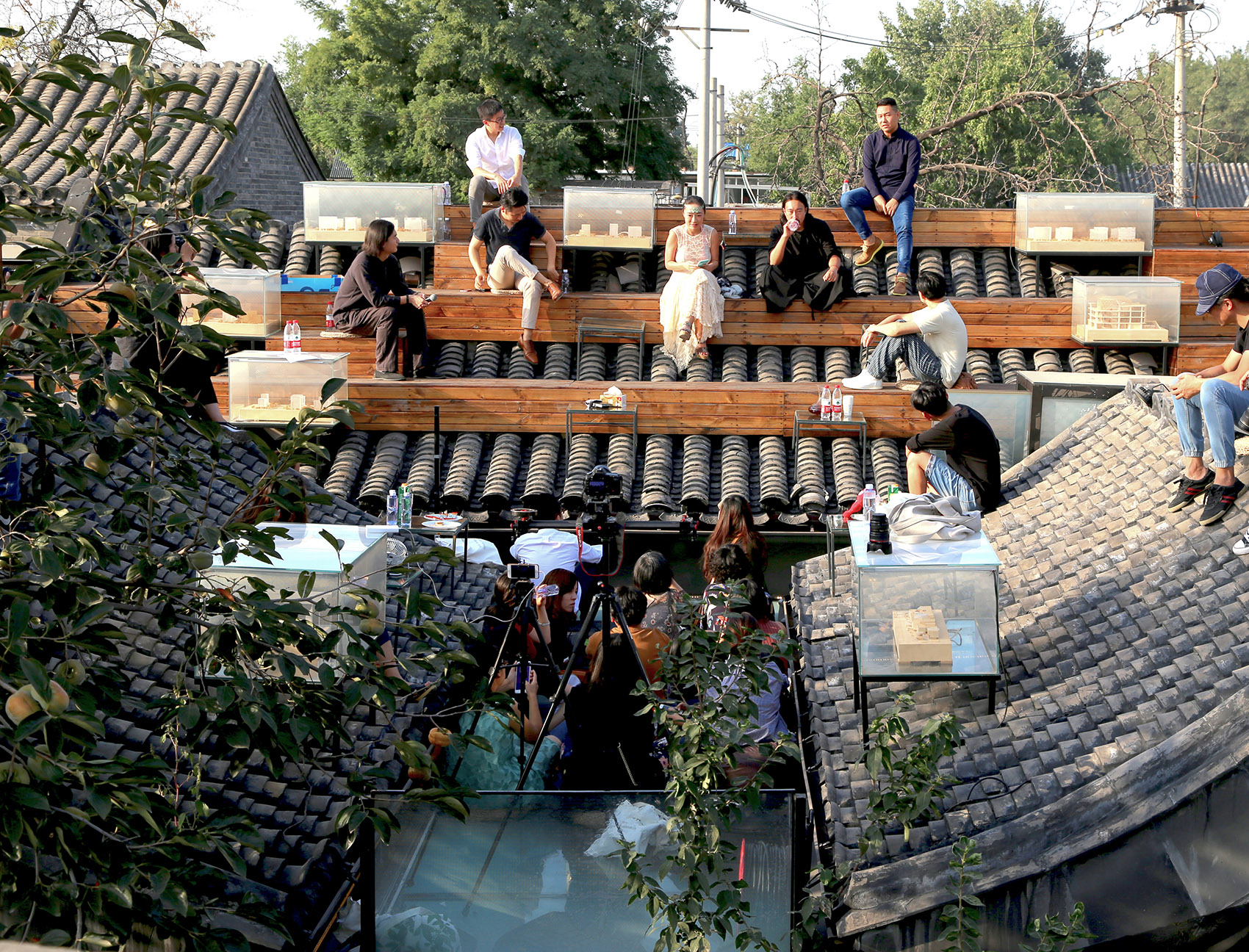
为支持北京中轴线申遗,鼓楼7号院自2021年10月27日恢复四合院古建原始风貌。屋顶部分装置现已拆除,期待下一次升级改造……
Since October 27, 2021 – to restore the original style of the ancient courtyard – the roof part of the transformation of Gulou No. 7 courtyard is being removed and looking forward to its next upgrade…
▼2021年立冬,北京迎来首场降雪,The first snow in Beijing, 2021 © BUZZ庄子玉工作室
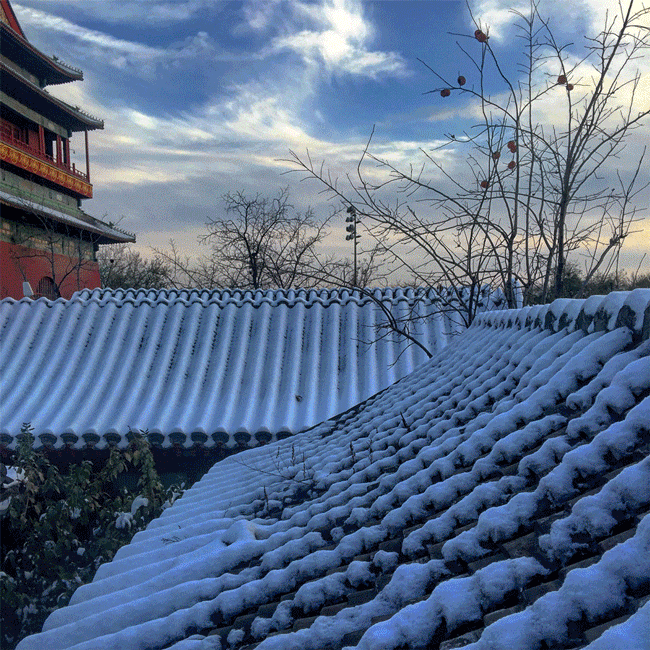
▼总平面图,Site plan © BUZZ庄子玉工作室

▼首层平面图,Ground floor plan © BUZZ庄子玉工作室
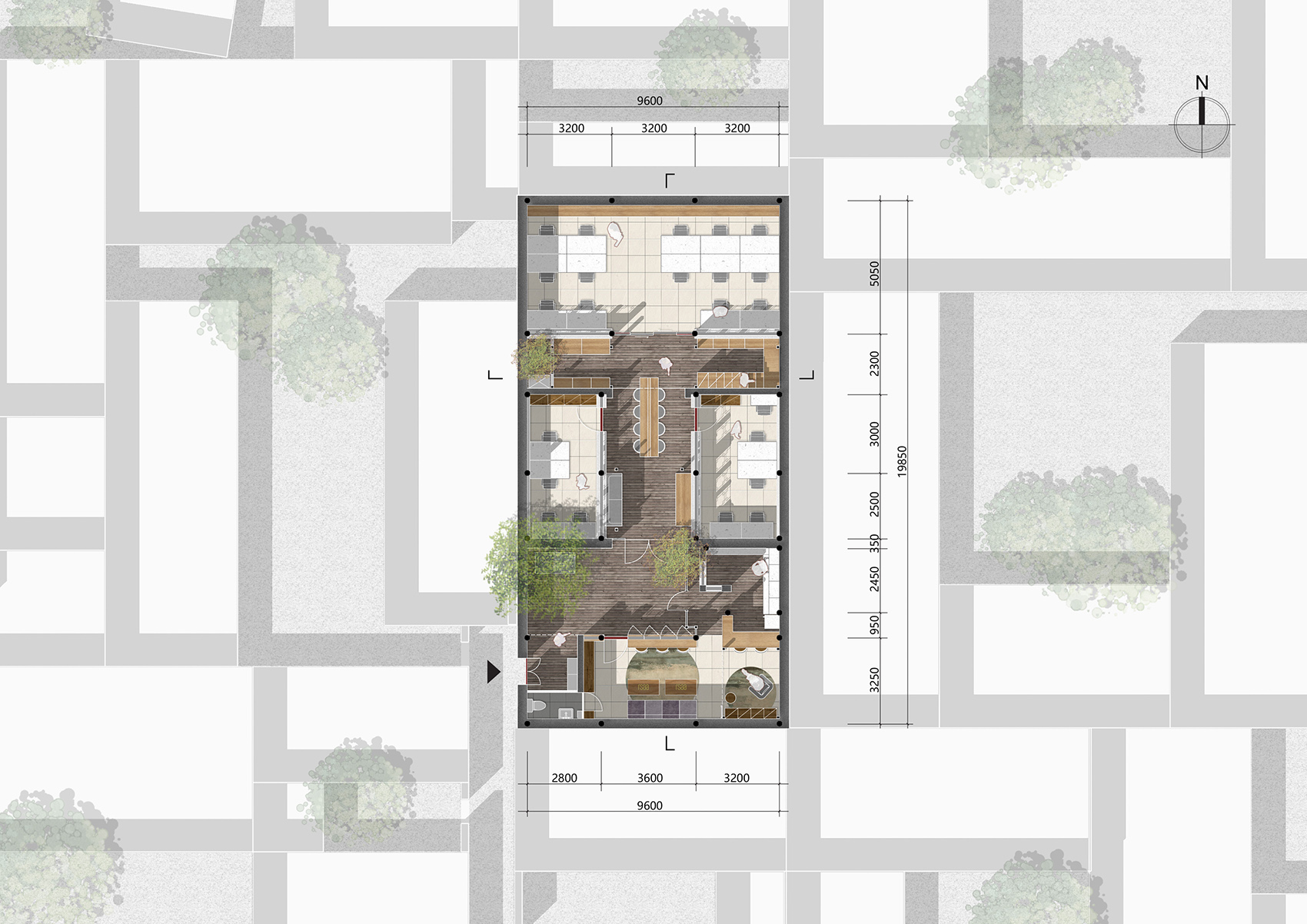
▼剖面图1-1,Section 1-1 © BUZZ庄子玉工作室

▼剖面图2-2,Section 2-2 © BUZZ庄子玉工作室

项目地点:中国北京 项目类型:历史建筑改造/办公建筑 建筑面积:230㎡ 建成时间:2015年 项目主创:庄子玉、李娜 建筑设计团队:刘毅, Fabian Wieser,张世峰,陈冬冬,柴文璞(实习生),李晓旭(实习生),王冕(实习生),黄俊雅(实习生)
Project Location: Beijing, China Project Type: Historic building renovation/office building Building area: 230m2 Completion date: 2015 Project creators: Zhuang Ziyu, Li Na Design Team: Liu Yi, Fabian Wieser, Zhang Shifeng, Chen Dongdong, Chai Wenpu (intern), Li Xiaoxu (intern), Wang Coronet (intern), Huang Junya (intern)
▼项目更多图片
